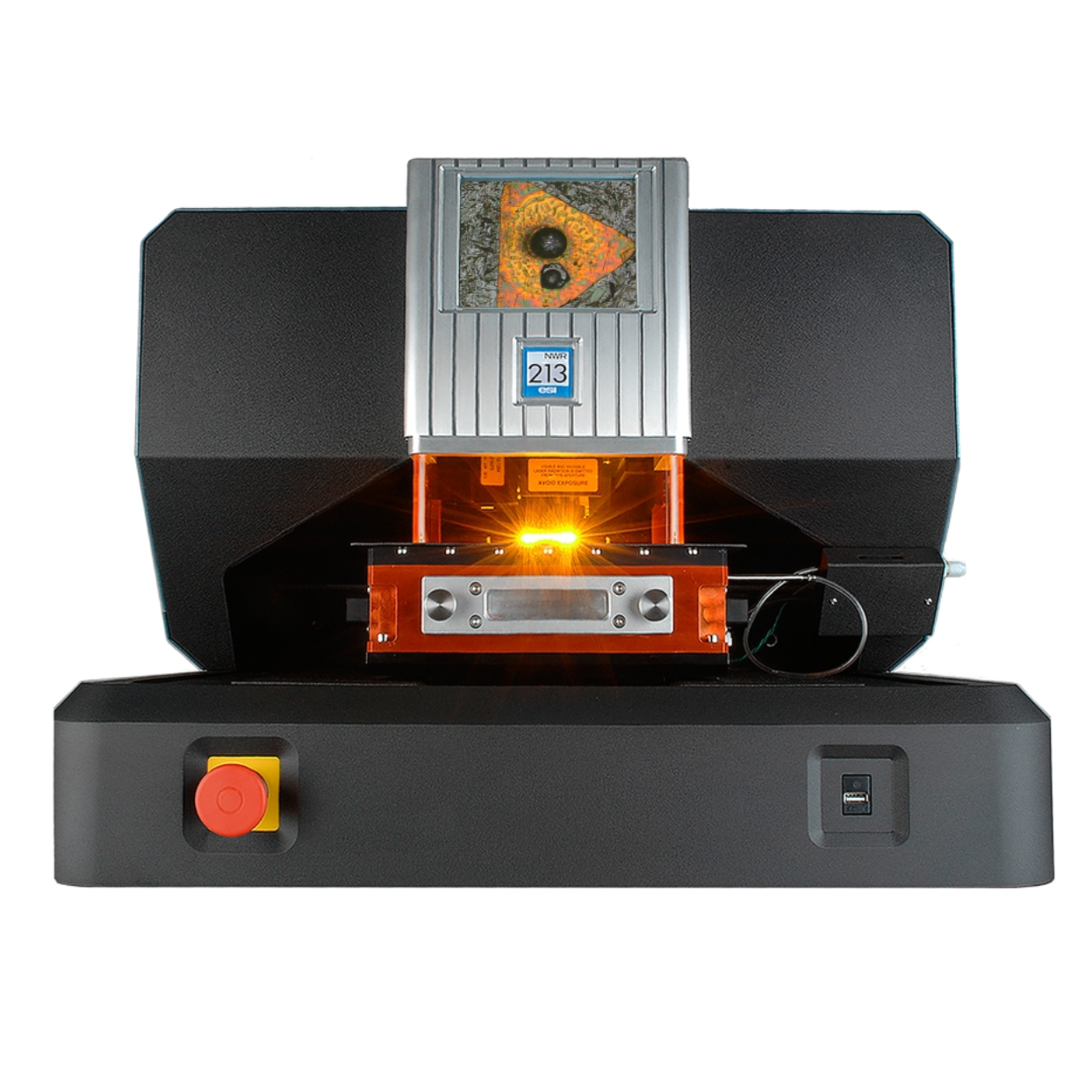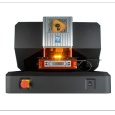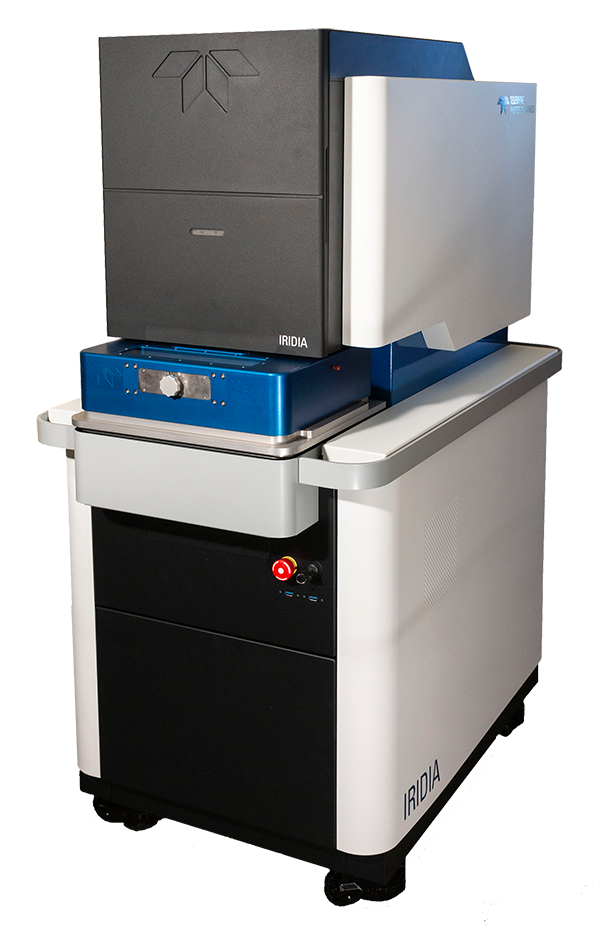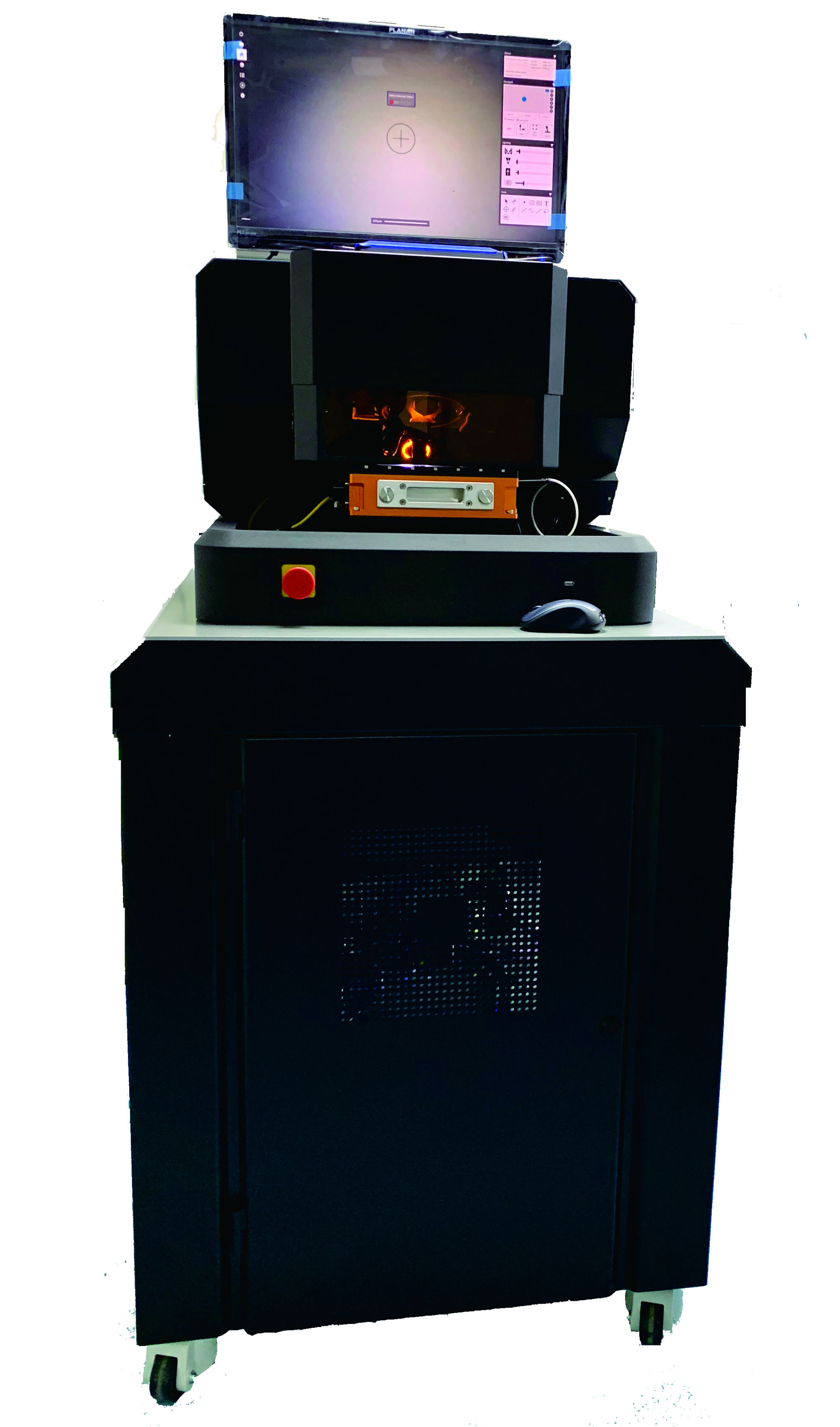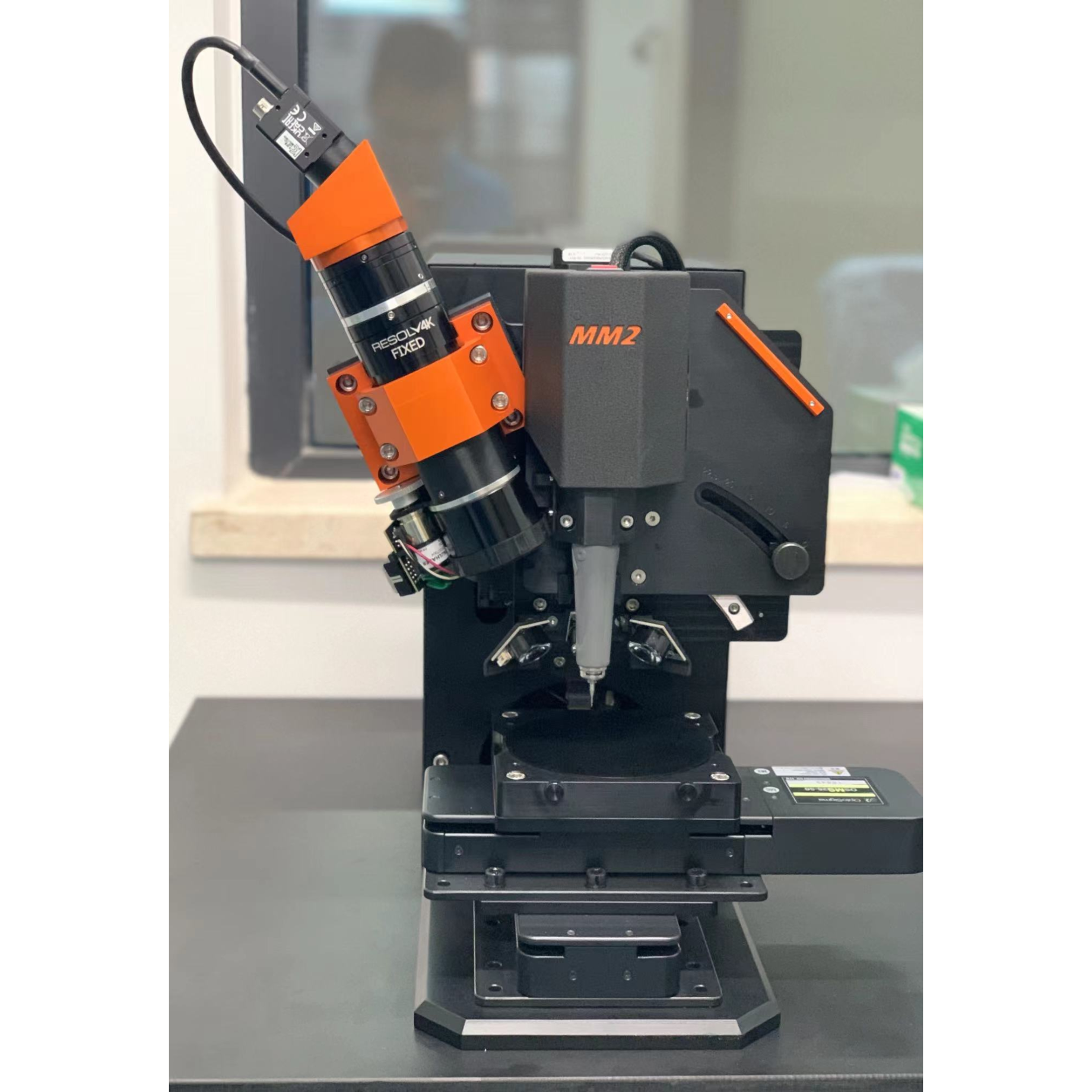在瑞典西南部的莫恩达尔,地质年代学研究的重点是霍西卡湖附近的一种具有基性层和横切伟晶岩脉的混合岩。本研究利用锆石LA-ICPMS U-Pb测年法获得的年份即岩石的地质历史,并将混合岩与波罗的海地盾西段的Kallebäck Suite相联系起来。岩浆结晶时代确定为1598±13Ma,其混合岩化年龄与挪威西部段变质峰的1030Ma相匹配。
方案详情

UNIVERSITY OF GOTHENBURGDepartment of Earth SciencesGeovetarcentrum/Earth Science Centre Data tables Zircon dating of theLake Horsika migmatite Rickard Haeggman Degree of Bachelor of Science with a major in Earth Sciences 15hec Department of Earth SciencesUniversity of Gothenburg 2015 B-875 UNIVERSITY OF GOTHENBURG Zircon dating of theLake Horsika migmatite Rickard Haeggman B875 Bachelor of Science thesis Goteborg 2015 Mailing address Address Telephone Telefax Geovetarcentrum Geovetarcentrum Geovetarcentrum 031-786 1956 031-7861986 Goteborg University S 405 30 Goteborg Guldhedsgatan 5A S-405 30 Goteborg SWEDEN Zircon dating of the Lake Horsika migmatite Rickard Haeggman, University of Gothenburg, Department of Earth Sciences Abstract A geochronological study focuses on a migmatite with mafic layers and cross cutting pegmatite veinsin the vicinity of Lake Horsika, in Molndal, SW Sweden. Using ages derived from LA-ICPMS U-Pbdating on zircons this study interprets the geological history of the rock and correlates the migmatite tothe Kalleback Suite in the Western segment of the Baltic shield. The magmatic crystallisation age isdetermined to be 1598 ±13 Ma and the migmatisation age matches the 1030 Ma Sveconorwegian peakmetamorphism in the Western segment. Key words: Migmatite, Zircon, U-Pb dating, LA-ICPMS,Kalleback Suite, Sveconorwegian. ISSN B875 2015 Zircon dating of the Lake Horsika migmatite Rickard Haeggman, University of Gothenburg, Department of Earth Sciences Sammanfattning En geokronologisk studie som fokuserar pa en migmatit med mafiska lager och korsandepegmatitgangar i narheten av sjon Horsika i Molndal, SV Sverige. Genom att anvanda aldrar ifran LA-ICPMS U-Pb-datering pà zirkoner tolkar den har studien stenens geologiska historia och korrelerarmigmatiten till Kallebacksviten i Vastra segmentet av den baltiska skolden. Den magmatiskakristallisationens alder ar bestamd till 1598 ±13 Ma och migmatiseringen overensstammer med den1030 Ma gamla Sveconorwegiska metamorfismens kulme i Vastra segmentet. Key words: Migmatite, Zircon, U-Pb dating, LA-ICPMS, Kalleback Suite, Sveconorwegian. ISSN B875 2015 Table of Contents Abstract ....1 Sammanfattning........2 .Introduction..........4 .Regional geology ........4 Kalleback and Frolunda Suites..... ..4 Local geology.......... ..5 Method...... 7 Preparing samples for dating .........7 Targeted zircons .... 7 Performing the dating .......... mmml Results............9 Ages.......10 BSE-SEM & microscopy ......14 Discussion..........15 Conclusions....16 Suggestions for further research...... .16 Acknowledgements........16 References........17 Appendix..........18 Introduction This study aims to decide if a migmatite in theGothenburg area is part of the 1600 Ma, gneissrich, Kalleback Suite or part of the 1560 MaFrolundaSuite, proposedbySarahMell(2005). Both units are very similar on a localoutcrop scale, and here best distinguished byzircon age populations. A previously unstudiedmigmatitelocatedaroundILake HForsika.Molndal,SW Sweden has been chosen as atest case. A positive correlation can providesupport for the existence of the suite. Thecorrelation is done by comparing ages and rocktypes. Dating is done using Laser Ablation-Inductively Coupled Plasma MassSpectrometry (LA-ICPMS) geochronology androck types are decidedusingopticalmicroscopy aanddaaBackScatter Electron-Scanning Electron Microscope (BSE-SEM). Regional geology Scandinavia is part of the 3-1.5 Ga Balticshieldwhichcovers Scandinavia,partsofEastern Europe and the Kareliannpprovince(Gorbatschev & Bogdanova 1993).Scandinaviacan befurther divided intodifferent zones and segments (Hegardt 2010,Ahall & Connelly 2008) (Fig.1). The relevantones for this study are the Eastern and theWestern segments as well as the MyloniteZone and Gota Alv Shear Zone. In generalthere is a sequence of rocks being youngertowards the West (Ahall, Persson, Skiold 1994,Gorbatschev & Bogdanova 1993). The Easternsegment isthe oldest, predating 1.66 Ga(Schersten, Larson, Cornell, Stigh 2003, Ahall& Connelly 2008). The Western segment isseparated from the Eastern segment by theMylonite Zone (Ahlin, Austin Hegardt, Cornell2006, Schersten et al. 2003, Hegardt 2010).The Western segment is characterised by agesbetween1.63 Ga and1.59 Ga. It consistsmainly of granodioritic plutonic rocks of calc-alkaline composition and volcanic rocks withdacitic composition (Hegardt 2010). The originof the segments is under debate. One Figure1.l。Map from Schersten et al. 2004.WS=Western segment, ES=Eastern segment. Otherareas mentioned in the map are irrelevant for thisstudy. The red square represents the region in whichthe studied area is situated (Fig.2). interpretation by Ahall and Connelly (2008) isthat the segments formed by several stages ofcontinental arc magmatism due to subduction.Another interpretation is thatttwooexoticterranes collided and formed theSveconorwegian province (Hegardt 2010). TheSveconorwegian continent-continent collisionreworked the Westernsegmentroughlybetween 1.15Ga and 0.90 GGaa (Ahall &Schoberg1999,Hegardt2010.Bingen,Nordgulen, Viola 2008). The Gota Alv ShearZone can be used as a vague boundary betweengranites with greenschist facies towards thewest and amphibolitic veining towards the Eastof the zone (Hegardt 2010). The Westernsegment has a general N-S trend (Hegardt2010). Kalleback and Frolunda Suites The Kalleback Suite islocated within theWestern segment in the eastern part of theGoteborg area (Fig.2) between the Gota AlvShear Zone and the Mylonite Zone (Mell2005). It consists of magmatic intrusions in thecontemporary volcanic and sedimentary AmalFormation (Ahall & Connelly 2008). Mellexplains that the suite is characterised by agesaround1600 Ma which has been furtheradapted to a time span of 1630-1590 Ma(Hegardt2010, Ahlinn et:al. 2005).TheKalleback: Suite consistss of red- too greygneissic and veined granites and granodiorites. Two kinds of pegmatitic veins have beenfoundin the suite.Augengneisses andmigmatites are common (Mell 2005). Mell (2005) proposes to differntiate a younger1560 Ma Frolunda Suite that consists partiallyof material from the Kalleback Suite and theStora Le-Marstrand formation. It has similarrock types to the Kalleback suite. They areprimarily distinguished by comparing ages andthat the Kalleback suite has two generations ofpegmatite, whereas the Frolunda suite onlyfeature one. Local geology Innageologicaall context, Lake IHorsikaaislocated in anareadominated by veinedgranodioritic gneisses in NNW-SSE direction(Samuelsson, 1982) (Fig.3). The majority ofthe rocks around the lake are deemed to begranodioritc, but there are streaks of granitesand tonalities as well. In the proximity thereare heavily migmatised and augen bearingrocks. Pegmatite intrusions are common. Thinlayers and lenses of metamorphosedamphibolites, also in a NNW-SSE direction, Figure 2. Geological bedrock map fit onto a satellite imageof the area. The red square marks the local area aroundthe Lake Horsika migmatite (Fig.3). Red dots marks spotsthat were proposed to belong to the Kalleback suite andblue dots belong to the Frolunda suite. Both suites areproposed by Mell (2005). Geological map data comes fromunpublished data by T.Eliasson, SGU and satellite image isfrom Google earth. are abundant. They are commonly foliated andrich in micas. In a mineralogical sense theyconsist mainly of hornblende and plagioclasebut are also rich in pyroxene. Quartz occursoccasionally (Samuelsson,1982). Area description The examined rock is situated in the Westernsegment in the Molndal municipality. It islocated at about 90 meters above sea level Figure 3.Modified map from Berggrundskartan 6B Kungsbacka NO (1965). Lake Horsika is located within theblue rectangle (Fig.4). The area is dominated by granodiorites. Heavily veined gneisses, migmatites and thin layersof metabasites occur commonly in a NNW-SSE orientation. Augen-bearing rocks are present in the SSE directionof the shearing. (WGS 57°38'406N 12°02990”E). The general strong NNW-SSE foliationdominates the rock (Fig.4) which is dividedinto three main units. The first main unit is migmatite (Fig.5) withbands in the NNW-SSEEc1direction.h.lThemigmatite displays metamorphic segregationconsisting of melanosomes and leucosomesrangingfrom millimetres to roughly twocentimetres. The leucosomes have a felsiccomposition with no preferred orientation andwith grain size approximate to 1mm. Alkalifeldspars are particularly large in comparisonto the other minerals. The grains from theleucosome are larger 1than those of themelanosome which consists mainly of biotiteand has a distinct preferred orientation. Thereare no traces of a mesosome indicating that therock is completely migmatised. Ata fewlocations small patches of augen gneiss arepresent in this unit. Withinntthe migmatite thee second unit ispresented as dark grey, mafic layers (Fig.6)with widths ranging from 5 to 30 cm. The mainmineral is biotite which occurs as foliatedlayers within the unit. Other dark grey to darkgreen rminerals areealsoppresent.t.It hasphaneritic grains;ywithadistinct preferredorientation. There are small traces of a whitemineral interpreted to be plagioclase. Streaksof rust are visible on weathered surfaces. The third unit consists of pegmatite veins withfelsic composition (Fig.7). There are two typesof veins. One type is straight with widths ofroughly 30 centimetres and the second type islarger veins ranging from 1 to 3 metres inwidth. They cross cut both the migmatite andthe dark layers indicating that pegmatite is theyoungest of the units. The sampled vein isapproximately 33 nmeterstthickand carriescentimetrewideeflakes of muscovitecandgarnets ass accessory minerals. There is noapparent oriented fabric. Figure 4. Satellite image of Lake Horsika. The spotswhere the samples were gathered is marked by red dots.RH15-1 is from the migmatite unit (Fig.5). RH15-3 isfrom the mafic layer unit (Fig.6). RH15-2 is from thepegmatite unit (Fig.7). A general NNW-SSE foliationtrend is visible. Images was captured using GoogleEarth. Figure 5. Migmatite. Bands of felsic materialinterlayered with biotite. Figure 6. Mafic layers in the migmatite. Figure 7. Pegmatitic vein cross cutting migmatite. Method Samples were gathered from the three mainunits of the rock. The first sample, RH15-1,was taken from migmatite. It consists of ~1kgof crushed rocks for zircon separation and alarge rock for a thin section. Thin sectionswere used for estimating the modal analysisusing opticaall microscopy and for furtherdeciding the incorporated minerals using BackScatterElectron Scanning ElectronMicroscop The second sample, RH15-2, wastaken from the thicker type of cross cuttingpegmatites. It also consists of ~1kg of crushedrocks for zircon separation and a large rock fora thin section, following the aforementionedprocedure. The third sample, RH15-3wastaken from a mafic layer. It consists of a largerock for a thin section. Zircon separation wasignored in this sample since zircons were notexpected to be found. Preparing samples for dating The zircons from samples RH15-1 and RH15-2had to be separated from the other minerals inthe samples. The samples were briefly crushedto pass through a 400 um sieve and thenpanned...Magnetic separationwasusedtoremovemagneticcrminerals. Zircons wereultimately separated by hand picking using abinocular microscopeeaand tweezers..Theseparated zircon grains were cast in an epoxypuck and polished for imaging with a HitachiS-3400N SEM and analysis with a NWR 213ESII1aserablation-systemcoupledto anAgilent 8800QQQICP-MS. The grains were numbered on photographsusinggSEM. Backscatter IElectron(BSE)pictures were taken to identify cracks in thegrains and Cathodo Luminescence (CL) wasused to distinguish cores from rims on thegrains. Spots for analysisw wiitthh LA-ICPMSwere chosen on fresh surfaces without crackswhere cores and rims were big enough for a20um wide beam to shoot without includingexcess material. Targeted zircons Different zones of zircons were targeted inorder to capture the whole spectrum (Table 1).Specialemphasis was taken to analysepotentiallyyyoungerr zzircon rims. Inthepegmatite sample three categories of zirconsbased on features visible with CL-SEM andBSE-SEM were analysed. One category beingeuhedral grains displaying bright using CL-SEM. Anotherbeing eeuuhledralilgrainsdisplaying dark using CL-SEM. The thirdcategory isirregular shaped, non-euhedralgrainswithhiirregular shapes and signs (ofdeformation. Table 1.Zircon domains dated. Sample Domain Distinguishing features RH15-1 cores CL-dark RH15-1 Rims CL-bright RH15-2 CL-bright Grains displaying CL-bright RH15-2 CL-dark Grains displaying CL-dark RH15-2 Performing the dating U, Th and Pb isotopes were measured usingLA-ICPMS. The primary standard used for theanalysis was the 1065 Ma 91500 (Wiedenbeck1995). GJ, KVT and occasionally BR266 wereused as secondary standards. Due to smallgrain size and thin rims a 20 micron beam wasused. Data batches were processed separatelyas A, B, C and D (appendix I). The batches were processed using a calculationprogram in Microsoft Excel 2010. Each batchcontained up to 38 spots, including standardsThe beamffromi theLA-ICPMS oftenpenetrated the rims and went into the core. Inorder to measure data from only the rims,separate batches had to be made with timeintervalscovering only therims innthespectrums. Ultimately batches A and B werecalculated twice for cores and rims. Batch C. was calculated three times for cores, rims and athird time since this batch included spots fromboth sample RH15-1 and RH15-2. Batch Dwas calculated once since it did not focus onrims. Spikes were removed from the spectrum ofeach analysed spot. Mean values and standarddeviations of the measured substances werecalculated and compared to those of the 91500standard to determine the age of the spot. Ageswere calculated from ratios estimated from206pb/238u, 207Pb/235u 208Pb/232Th and207Pb/206Pb. Common lead corrections were notmade but spots yielding significantly high204Pb signal were removed. Isoplot v.4.15 (Ludwig 1991,1998) was usedto determine concordia, intercept and weightedmean ages. Allages are given at the 2oconfidence level. Results The RH15-1 migmatite is rich in zircons. Theyare generally around 100um long but can befrom 170um and to 60um (Fig.8, Table 2).Cracks are common. Cores are CL-dark whilethe rims are CL-bright. The CL images showthat the cores are large while the rims are thin(Fig.8). Core Th/U ratios range from around0.2 to 1. Rim Th/U ratios range from around Oto 0.2 (Table2). RH15-2 zircons are more scarce compared tothe previous sample.. The irregular shapedzircons (grain 12, Fig.9) are generally largest.They can be up to 100um on the c-axis and upto 65um on the b-axis. Their Th/U ratios rangefromaaround 0.1 to 0.8. They featureinclusions, many cracks of different sizes,rounded edges and oscillatory zoning (Table2). Furthermore, they are barely visible inCathodo Luminescence suggesting they havehigh Th+U contents.The CL-dark zircondomain (grain 21, Fig.9) has a roundtoelongated shape and often has sharp edges andeuhedral form. They do not have many cracks,any oscillatory zonation or inclusions. TheirTh/U ratios range from around 0.5 to 2 (Table2). CL-bright zircons (grain 22, Fig.9) arecharacterised by being round to elongated withsharp edges (Table 2). They generally haveeuhedral shape and few cracks. No zonation isseen. They sometimes have a thin CL-brightrim. CL-brighness indicate lower amount ofTh+U. Their Th/U ratios range from around0.45 to 1. The CL-dark and CL-bright grainsrange from 50um to 100um on the c-axis(Fig.9,Table 2). Duringtthe calculationssome data Wasremoved and some reclassified((Tabliee33).Several rim spots were treated as cores. DuringLA-ICPMS-analysis on some spots, the laserwent through the rim and into the core andultimately recordedmore data from corematerial than rim material. Other grains werereclassified as cores due to having high Th/Uratios. A Magmatic zircon generally hasaTh/U ratio greater than 0.4 while a Figure 8. Backscatter (Top row) and CathodoLuminescence(Bottom row)images of someanalysed grains from sample RH15-1. BS-imagesdisplay many cracks while CL displays rim materialas bright and core material as dark. Note that thegrainss were not photographed using the samesettings, hence a comparison of brightness betweengrains is not possible. Red circles marks spotsanalysed with LA-ICPMS, also displaying the actualbeam size. Figure 9.Backscatter (Top row))aandCathodoLuminescence(Bottom row) images ofsomeanalysed grains from sample RH15-2. Grain 12 is axenocryst, grain 21 is CL-Dark and grain 22 is CL-Bright. CL-images of grain 12 and 21 are not addedin the figure since they are only barely visible.Notethat the grains were not photographed using thesame settings, hence a comparison of brightnessbetween grains is not possible. Red circles marksspots analysed with LA-ICPMS, also displaying theactual beam size. metamorphic one has a Th/U ratio less than 0.1(Rubatto 2001). Hence, rim measurementswith Th/U ratios substantially higher than 0.1were treated as cores. Ages The RH15-1 migmatite data is shown in Fig.10. A regression using 28 spots yields anupper intercept age of 1604 ±13 Ma withMSWD 1.10 and probability of fit 0.33. Thespot 10a are not used in calculations foryielding a significantly older age and spot21a is not used due to poor precision. Aconcordia calculation based on 11 pointswith discordance less than 3% givesconcordia age of 1598 ±13 Ma with MSWD0.0006 and probability of fit 0.98 (Fig.11).Using the same11 spots; the weightedaverage 206pb/207Pb age is1S1589 ±19 Ma(Fig.12) with MSWD 0.47 and probabilityof fit 0.91. The rims shown in Fig.13display alarge scatter which suggestsmixing of domains and possibly influencesof common lead yielding older Pb-Pbages.However, the data seem to trend towards aSveconorwegian intercept on Concordia.Five nearly concordant spots with Th/Uratios below 0.03 yield a weighted averagePb-Pb age of 1060 ±77 Ma with MSWD1.11 and probability of fit 0.34 (Fig.13). Sample RH15-2 produced two ages (Fig.14).The first is a 206Pb/207Pb weighted average Figure 10. The intercept age of RH15-1 migmatite coresbased on 28 points is 1604±13 Ma. data-point error ellipses are 68.3% conf. Figure 11. The concordia age of RH15-1 migmatitecores based on 11 points with discordance less than3%. The age is determined to be 1598 ±13 Ma. Thegrains used for calculations are 3a, 16a,37a,50a, 55a,58a,75a,88a,91a,92a and 101a from the RH15-1sample. Sample Domain CL Crystal shape (of whole grain) Size Th/U RH15-1, Migmatite Core Dark Euhedral, sharp edges, elongated 60-170um~0,2-1 RH15-1,Migmatite Rim Bright Euhedral,sharp edges,elongated 60-170um ~0-0,2 RH15-2,Pegmatite CL-bright Bright Euhedral, dull edges, elongated, sometimes slightly deformed 50-100um~0,45-1 RH15-2,Pegmatite CL-dark Dark Euhedral, dull edges, round to elongated, sometimes slightly deformed 50-100um ~0,5-2 RH15-2, Pegmatite Irregular shaped Dark Truncated, zonation, rounded edges, inclusions, deformed shapes ≤100pm ~0,1-0,8 Table 3. Grains that were removed or reinterpreted during the calculation process. Removed or reinterpreted spots Action Reason age on CL-bright zircons, excluding grain22 which has a different age of 1178 Ma.Spot 32 was also excluded for being 41%discordant. This age is 1608 ±26 Ma withMSWD 0.70 and probability of fit 0.59. Thesecond age is a 1178 ±16 Ma concordia agefor three spots on the CL-bright grain 22with MSWD 0.27 and probability of fit 0.61.Due to common lead issues in every zirconof the irregular shaped domain, except 12a,it was not possible to achieve a reliable agecalculation on this kind of zircon. Grain 12a,which is the only irregular shaped zirconwhich does not have a high common leadsignal, is far younger than any other of thezircon domains (Fig.14). Ages from the CL-dark type vary too much in order to producea useful age. Figure 12. The age of RH15-1 migmatite coresbased on weighted average of 206Pb/27Pb ages.Calculations are basedon 11points withdiscordance less than 3%. The calculated age is1589 ±19 Ma. Figure 13. The 206Pb/27Pb weighted average fromthe RH15-1 migmatite rims based on 5 points withTh/U ratios lower than 0.03. The age of the rims is1060 ±77 Ma. Points used in calculations aremarked with red colour. 207Pb/235U Figure 14. The intercept age of CL-bright zirconsfrom the RH15-2 pegmatite excluding the threespots from grain 22. The age is calculated to be 1608±26 Ma. The 1178 ±16 Ma concordia age of the CL-bright grain 22 based on three spots (red). CL-bright is marked with orange. CL-dark is black. Theonly irregular shaped zircon without common leadissues, grain 12, yields a younger age compared tothe other domains. The raw data and ages for each spot are presented inTables 4, 5 & 6 below. Raw data for the standards usedin the calculations are presented in appendix II, III andIV. Table 4. Ratios and ages from measurements on cores in sample RH15-1. Migmatite core ages from ratios Ratio Ratio Ratio Rho Ratio Age (Ma) Age (Ma) Age (Ma) Age (Ma) Discordance RH15-1 208/232 207/235 206/238 207/206 208/232 207/235 206/238 207/206 % Batch Spot Type U Th Th/U 1s 1s 1s 1s 1s 1s 1s 1s A 10a Core 310 112 0,36 0,094 4,576 0,333 0,93 0,099 1812 1745 1853 1609 18,1 0,008 0.182 0,015 0,002 147 34 71 30 A 10b Core 199 132 0,66 0,091 4,144 0,305 0,92 0,098 1766 1663 1715 1590 9,4 0,008 0,157 0,013 0,002 142 31 64 30 A 16a Core 239 99 0,41 0,081 3,777 0,279 0,92 0,098 1578 1588 1586 1580 1,0 0,007 0,145 0,012 0,002 128 31 60 30 A 17a Core 149 135 0,91 0,085 3,643 0,265 0,92 0,099 1639 1559 1517 1608 6,0 0,007 0,139 0,011 0,002 133 31 57 31 A 18a Core 535 130 0,24 0,085 3,879 0,286 0,93 0,098 1642 1609 1624 1584 3,3 0.007 0.148 0,012 0,002 132 31 61 30 A 19a Core 241 148 0,62 0,085 4,009 0,293 0,92 0,099 1657 1636 1656 1602 4,3 0,007 0,152 0,012 0,002 133 31 62 30 A 2a Core 383 204 0,53 0,067 3,516 0,252 0,93 0,101 1304 1531 1451 1638 12,5 0,006 0,138 0,011 0,002 108 32 57 30 A 3a Core 205 161 0,78 0,084 3,621 0,272 0,92 0,096 1632 1554 1551 1550 0,5 0,007 0.138 0,011 0,002 131 31 58 31 A 3b Core 230 98 0,43 0,080 3,263 0,239 0,92 0,098 1562 1472 1384 1594 14,3 0,007 0,126 0,010 0,002 127 31 54 31 A 4a Core 666 693 0,006 0,148 Table 5. Ratios and ages from measurements on rims in sample RH15-*. RH15-1 208/232 207/235 206/238 207/206 208/232 207/235 206/238 207/206 % Batch Spot Type U Th Th/U 1s 1s 1s 1s 1s 1s 1s 1s A 30a Rim 28,74 0,33 0,01 1,576 0,157 0,59 0,073 961 939 1028 10,0 0,073 0,006 0,003 29 35 80 A 30b Rim 15,35 0,26 0,02 1,602 0,148 0,45 0,081 971 888 1212 30,3 0,085 0,006 0,004 34 35 100 A 31a Rim 36,18 2,26 0,06 4,923 0,204 0,51 0,180 1806 1195 2656 61,2 0,230 0,009 0,008 40 47 74 A 31b Rim 31,90 0,60 0,02 2,237 0,149 0,67 0,109 1193 897 1780 53,1 0,105 0,006 0,004 34 34 66 A 35a Rim 29,73 0,22 0,01 2,575 0,154 0,80 0,129 1294 923 2080 61,9 0,180 0,006 0,011 52 36 153 B 42a Rim 23,71 0,64 0,03 1,424 0,142 0,72 0,073 899 857 1026 18,4 0,089 0,006 0,003 38 37 88 B 42c Rim 219,11 41,28 0,19 0,138 2,515 0,187 0,88 0,097 2609 1276 1108 1563 31,3 0,023 0,162 0,010 0,003 408 48 55 58 B 47a Rim 16,09 0,69 0,04 6,562 0,199 0,78 0,241 2054 1168 3127 68,4 0.390 0,009 0,009 54 48 60 B 51a Rim 520,30 68,80 0,13 0,085 3,666 0,266 0,88 0,099 1651 1564 1520 1614 6,0 0,007 0,200 0,011 0,003 127 44 58 49 B 75b Rim 58,07 8,61 0,15 0,157 3,564 0,256 0,83 0,101 2947 1541 1471 1643 11,9 0,023 0,199 0,011 0,003 398 45 58 58 B 84a Rim 15,47 0,33 0,02 1,805 0,171 0,75 0,076 1047 1019 1107 8,7 0,115 0,008 0,003 43 43 84 *208/232 ages are not reported if o<10ppm Table 6. Ratios and ages from measurements in sample RH15-2. Pegmatite ages from ratios Ratio Ratio Ratio Rho Ratio Age (Ma) Age (Ma) Age (Ma) Age (Ma) Discordance RH15-2 208/232 207/235206/238 207/206 208/232 207/235 206/238 207/206 % Batch Spot lype U Th Th/U 1s 1s 1s ls 1s 1s 1s 1s D 18a CL-Bright 184,8 129,6 0,70 0,088 4,003 0,288 0,87 0,100 1697 1635 1632 1632 0,3 0,006 0,086 0,008 0,001 116 18 41 27 D 22a CL-Bright 115,0 49,2 0,43 0,060 2,214 0,204 0,82 0,079 1181 1185 1195 1165 3,0 0,005 0,049 0,006 0,001 87 16 31 32 D 22b CL-Bright 156,8 77,7 0,50 0,062 2,136 0,195 0,83 0,079 1220 1161 1149 1172 1,7 0,005 0,049 0,006 0,001 87 16 30 32 D 22c CL-Bright 128,9 64,6 0,50 0,064 2,244 0,208 0,82 0,078 1246 1195 1218 1147 7,2 0,005 0,051 0,006 0,001 89 16 32 32 D 29a CL-Bright 135,5 59,6 0,44 0,072 3,120 0,228 0,81 0,100 1407 1438 1326 1616 20,3 0,005 0,067 0.007 0,002 103 17 35 32 D 29b CL-Bright 174,2 78,5 0,45 0,065 3,292 0,243 0,85 0,098 1274 1479 1404 1586 12,7 0,005 0,071 0,007 0,002 92 17 36 29 D 32a CL-Bright 128,2 102,2 0,80 0,061 3,090 0,195 0,59 0,115 1189 1430 1149 1879 42,4 0,005 0,092 0,006 0,003 88 23 30 48 D 54a CL-Bright 208,2 209,8 1,01 0,092 4,251 0,312 0,86 0,098 1786 1684 1750 1595 11,5 0,007 0,093 0,009 0,001 121 18 44 28 D 54b CL-Bright 202,1 139,5 0,69 0,091 4,313 0,314 0,87 0,100 1755 1696 1758 1615 10,3 0,006 0,094 0,009 0,001 120 18 45 27 C 6a CL-Bright 503,0 433,0 0,86 0,082 BSE-SEM & microscopy The composition of the RH15-1 migmatitebased on BSE-SEM and microscopy includesthe following minerals: quartz, plagioclase, K-feldspar, biotite, epidote, apatite, zircon, pyriteand magnetite. The leucosomesCconsistmainly of felsicminerals with a modal distribution of ~40%quartz, ~40% plagioclase and ~20% alkalifeldspar, which plots as granodiorite on QAPF-diagram. Pyrite occurs as accessory mineral.The melanosome consists almost entirely ofbiotite but includes big, euhedral grains ofepidote, zircon, apatite and magnetite as smallaccessory minerals. The thin section displaysedgesof quartz grainsmelting together,perthitic K-feldspar and myrmekite. Clusters ofvery small, felsic grains and large myrmekiticgrains are common. Thee IRH15-2 pegmatitecontains quartz,plagioclase, K-feldspar, apatite, muscovite,zircon and garnet. Due to the large grain size itis hard to estimate modal proportions. Aroughestimate based on hand samples yields ~15%quartz, ~35% plagioclase and ~50% alkalifeldspar plotting as monzonitic on a QAPF-diagram. The RH15-3maficc layer containsquartz,plagioclase, biotite. epidote, apatite,hornblende, titanite, ilmenite and magnetite.The biotite has a strong preferred orientation.There seemss to beaneven distributionbetween hornblende, felsic material of quartzand plagioclase and biboitoittiet.e .T This rockisinterpreted as a biotite rich amphibolite. Data yielded by BSE-SEM analysis was givenin poor precision. For BSE-SEM results, seeappendix V & VII. Discussion Of the three RH15-1 core ages the 1598 ±13Ma concordia age seems to be the most reliableone. It is based on sufficient data with lowdiscordance, low MSWD and a probability offit close to 1. It has the same error as the 1604±13 Ma intercept age which is based on 28spots, but has a significantly higherprobability. The RH15-1 core age isinterpreted to represent the magmaticcrystallisation age of the rock which couldhave originated either as a volcanic or intrusiverock. The cores have high Th/U ratios whichindicate them to be magmatic. The 1598 ±13Ma age fits into the 1.63-1.59 Ga age of theWestern segment. The rim intercept age of 1060 ±77 Ma isimprecise and based on only part of the rimdata. The main reason for the poorly definedintercept is that the rims are very small. TheLA-ICPMS beam was often as wide as therims. Hence. shots on the rims were easilycontaminated byycore material. Mixingbetween core and rim is likely since there aremany rims with Th/U ratios between 0.1 and0.4. Since the time interval had to be changedin cases where core material was removedfrom the rim spectrums, there was less data tomakee good meanvvalues andSstandarddeviations for samples and standards alike. The age is deemed good enough to use forthree reasons. The five used points have lowTh/U which makes them less likely to havebeen mixed with core material. The points areclustered on the concordia line. The third andmost important reason is that the age agreeswith the peak of Sveconorwegianmetamorphism date of 1050 Ma to 1030 Ma inSouth West Sweden (Bingen, et al. 2008,Hegardt 2010). The migmatisation of the rockis thus interpreted to be Sveconorwegian. For amigmatiteto form, high gradeleregionalmetamorphism and hydrous conditions aiarenecessary (Kearey, Klepeis, Vine 2009, p.277). A continent-continent collision should providesuch high grade metamorphism. CL-bright zircons from the RH15-2 pegmatiteprovide a 1608 ±26 Ma age. It is within erroridentical to the magmatic crystallisation of themigmatite cores, but the CL-bright zirconsfrom the pegmatite do not have the same well-developed CL-bright rims as the zircons fromthe migmatite. The CL-bright RH15-2 zirconsare interpreted to be relict zircons from countryrock below which was transported upwardsduring the pegmatite intrusion. It can havecrystallised at the same time as the migmatitecores. but was not as exposed totltheSveconorwegian metamorphism and did notform as big rims as those from the RH15-1sample. Grain 22 from the same sample is interpretedas an 1178 ±16 Ma relict zircon picked up bythe pegmatite from the underlying rock duringits intrusion event. The pegmatite cross-cutsthe migmatite indicating that the pegmatitemust be the younger of the two. The 1178 Maage of grain 22 predates the Sveconorwegian:hence the grain cannot represent the intrusionof the pegmatite. Given that the migmatisationevent is Sveconorwegiannandthatpegmatite Cross cuts thee mnigmatite,pegmatitic intrusion should be lateSveconorwegian or younger. The irregular shaped types of zircons in RH15-2 could not be dated. Since they have smallresemblance to the other zircons regardingshapes, size, deformation and zoning they areinterpreted to be xenocrysts. It is likely theywere transported from the country rock belowby the pegmatite intrusion event. From the results outlined above, one canconclude that the rocks around Lake Horsikaare likely part of the Kalleback Suite. The1598±13 Ma migmatite age is within the rangeof ages that defines the suite. The lake islocated close to the geographical range of thesuite. The migmatitee beingg granodioriticcorrelates well with Kalleback suite consisting of gneissic and veines granites andgranodiorites. Lake Horsika has two types ofpegmatites present which distinguish the rockfrom the slightly younger Frolunda suite whichonly display one pegmatite generation (Mell2005). Furthermore the migmatite can be compared tothe Delsjon Augengneisswhich wasinterpreted as a part of the same suite by Ahlinet al. (2006). Delsjon is situated ~5 Km to theNorth ofLake Horsika and featuresaugengneiss with an age of 1614 ±5 Ma aswell as a migmatite sample dated to 1618 ±7Ma. It includes plagioclase, quartz and K-feldspar augen as well as aggregates of biotitewith epidote, apatite, zirconsand opaqueminerals. Gabbroic intrusions are present thereas well. The ages are within error to those ofLake Horsika. They both feature augen gneissand migmatite as well as mafic inclusions. Thesimilarities in mineralogy, rock types and agesas well as the small distance between themprovide good reasons to correlate them. It would be interesting to find out whether theLake Horsika migmatite was formed from asupracrustal or plutonic protolith. With suchinformation it could be distinguished from thevolcanic and sedimentary Amal Formationwhich was formed in the same time range asthe Kalleback Suite (Ahall & Connelly 2008).It could also be further correlated to theplutonic Kalleback Suite. It was impossible todetermine the protolith since the rockiscompletely migmatised, hence displaying nomesosomes for REE analysis. Conclusions The rock around Lake Horsika was formed1598 ±13 Ma ago and was reworked intomigmatite during the Sveconorwegianmetamorphism. Lake Horsika is most likelypart of the Kalleback Suite. It is located closeto the area of the Kalleback Suite. Ages, androck types can be related to the description ofthe suite and also to the nearby Delsjonaugengneiss which is part of the same suite.Hence the migmatite around Lake Horsika isinterpreted to be part of the Kalleback Suite. Suggestions for further research Dating on several more zircon grains from thepegmatite could be done. If monazite could befound it could also be dated. Such data couldyielddan intrusion aage of the pegmatite Better dating could be performed on zirconrims from Lake Horsika to see if there is a rimcontemporary to the forming of the 1560 MaFrolunda Suite. .Acknowledgements I want to thank Professor David Cornell forsupervising this project and for providingmuch support and constructive advice duringthe process of the project. I am very thankfulthat he gave me the opportunity to study thisparticular rock. Eric Ackevall provided amacro which saved me hours of manual work.I want to thank Emily Zack for making thinsections. I also want to thank Freja Gullberg,Torunn Oscarsdotter Pindamo. ElisabetSundberg aand Wictor Enquist for peerreviewing the report. Finally I want to thankProfessor Thomas Zack for being the examinerof the project. References Ahlin,S., Austin Hegardt, E., Cornell, D. H.(2006). Nature and stratigraphic position of the 1614 Ma Delsjonaugen granite-gneiss in the Median Segment of south-west Sweden. GFF, 128:1, 21-32 Austin Hegardt, E. (2010). Pressure, Temperature and Time Constraints on Tectonic Models for SouthwesternSweden. Ph.D. thesis. Goteborg University. Goteborg, Sweden. Berggrundskartan 6B KUNGSBACKA NO. (1965). Sveriges Geologiska Undersokning, Serie Af, Nr 124 Bingen, B., Nordgulen, O.,Viola,G. (2008). A four-phase model for the Sveconorwegian orogeny, SWScandinavia. Norwegian Journal ofGeology, 88, 43-72 Eliasson,T,. (2015). Sveriges GeologiskaUndersokning. Falkum, T., & Petersen,J. S. (1980). The Sveconorwegian Orogenic Belt, a case of Late-Proterozoic Plate-Collision. Geologische Rundschau,Vol.69:3, 622-647 Gorbatschev,R., & Bogdanova, S.(1993). Frontiers in the Baltic Shield. Precambrian Research, 643-21 Kearey, P., Klepeis, K. A., Vine, F. J. (2009). Global Tectonics. West Sussex, UK: Wiley-Blackwell. Ludwig, K.R. 1991. Isoplot: a plotting and regression program for radiogenic isotope data. USGS Open filereport, 91-445 Ludwig, K.R. 1998. On the treatment of concordant uranium-lead ages. Geochimica et Cosmochimica Acta, 62,665-676 Mell, S. (2005). A Geochemical investigation of 1600 Ma and 1560 Ma Granitoids, Western Segment, SWSweden. M.Sc. Thesis, Goteborg University, Goteborg, Sweden. Rubatto, D. (2001). Zircon trace element geochemistry: partitioning with garnet and the link between U-Pb agesand metamorphism. Chemical Geology, 184, 123-138 Samuelsson, L. 1982. Beskrivning till berggrundskartan KUNGSBACKA NO. Sveriges GeologiskaUndersokning, Serie Af, Nr 124 Schersten, A., Larson, S.A., Cornell, D.H., Stigh, J.(2003). Ion probe dating of a migmatite in SW Sweden: thefate of zircon in crustal processes. Precambrian research, 130, 251-266 Wiedenbeck, M., Alle, P., Corfu, F., Griffin, W. L., Meier, M., Oberli, F., Von Quadt, A., Roddick, J. C.,Spiegel, W. (1995). Three Natural Zircon Standards for U-TH-PB,Lu-Hp, Trace Element and REE Analyses.Geostandards Newsletter, 1, 1-23 Ahall, K. -I. (1989). Crustal growth and evolution of the Proterozoic Ostfold-Marstrand Belt,SW Sweden. Ph.D.thesis. Chalmers Tekniska Hogskola & Goteborgs Universitet, Geologiska Institutionen. Goteborg, Sweden. Ahall, K. -I., & Connelly, J.N.(2008). Long-term convergence along SW Fennoscandia:330 m.y. ofProterozoic crustal growth. Precambrian Research, 161, 452-472 Ahall, K. -I., Persson, P. O., Skiold, T. (1994). Westward accretion of the Baltic Shield: implications from the1.6 Ga Amal-Horred Belt, SW Sweden. Precambrian Research, 70, 235-251 Ahall,K. -I.,& Schoberg, H. (1999). The 963 Ma Vinga intrusion and post-compressional deformation in theSveconorwegian orogen, SW Sweden. GFF, 121:2,101-106 Appendix Appendix I. The run list for the LA-ICPMS session. All spots divided into four batches for data processing. Spotsfrom RH15-1 are marked with green background and RH15-2 has purple background. GJ Standard 22b CL-bright 91500 Standard 32a CL-bright Batch C Batch D 91500 Standard 3b 4a 4a2 2a 9a 10a 10b 17a GJ GJ 18a 16a CoreRimCoreCoreRimCoreCoreCoreCore91500 Standard91500 StandardStandardStandardKVT StandardKVT StandardRimRim21a Core19a Core30a Rim30b Rim31a Rim31b Rim35a Rim91500 Standard91500 StandardGJ StandardGJ StandardKVT StandardKVT StandardBR266 StandardBR266 Standard91500 Standard 91500 Standard GJ Standard GJ Standard KVT Standard 1b CL-dark GJ Standard 18a CL-bright GJ Standard 12a Irregularshaped 29a CL-bright 91500 Standard 20a CL-dark GJ Standard GJ Standard 91500 Standard 12b Irregular shaped 92a Rim 12c Irregular shaped 412a Other sample 405a Other sample 103a Rim 110a Rim 25a CL-dark 126a Rim 25b CL-dark 131a Rim 33a Irregular shaped 91500 Standard 46a Irregular shaped 91500 Standard 91500 Standard GJ Standard 91500 Standard GJ Standard GJ Standard GJ Standard BR266 Standard KVT Standard GJ Standard KVT Standard KVT Standard BR266 Standard KVT Standard BR267 Standard BR266 Standard 2a Irregular shaped BR266 Standard 53a CL-dark 6a CL-bright Appendix. II. Standards used for calculating the RH15-1 migmatite cores. The main standard 91500 is 1065 Ma. GJ,KVT and BR266 are 605 Ma, 3227 Ma and 562 Ma respectively. Standards for RH15-1 migmatite cores Age (Ma) Ratio Ratio Ratio Rho Ratio Age (Ma) Age (Ma) Age (Ma) 208/232 207/235 206/238 207/206 208/232 207/235 206/238 207/206 % Batch StandardU Th Th/U 1s 1s 1s 1s 1s 1s 1s 1s A 91500 77 27 0,35 0,059 1,867 0,180 0,88 0,076 1161 1070 1066 1084 2,1 0.005 0,075 0,008 0,002 103 27 43 42 A 91500 84 31 0,36 0,054 1,829 0,178 0,89 0,075 1062 1056 1057 1061 0,8 0,005 0,072 0,008 0,002 93 26 42 40 A 91500 86 32 0,38 0,053 1,773 0,170 0,89 0,075 1051 1036 1014 1078 6,3 0,005 0,069 0,007 0,001 91 26 40 38 A 91500 86 31 0,36 0,052 1,763 0,169 0,89 0,076 1015 1032 1004 1088 8,1 0,005 0,069 0,007 0,001 90 26 39 39 A GJ 331 13 0,04 0,031 0,768 0,094 0,91 0,059 609 579 577 574 1,0 0,004 0,030 0,004 0,001 71 17 23 38 A GJ 333 13 0,04 0,026 0,754 0,091 0,91 0,060 513 571 561 600 6,4 0,003 0,029 0,004 0,001 61 17 23 38 A KVT 15 9 0,61 0,185 23,073 0,653 0,91 0.256 3434 3230 3239 3224 0,6 0,017 0,896 0,028 0,005 287 39 110 29 A KVT 25 11 0,44 0,194 22,393 0,625 0,91 0,260 3580 3201 3129 3244 4,3 0,017 0,858 0,027 0,004 295 38 107 27 A 91500 77 30 0,39 0,057 1,972 0,188 0,90 0,076 1126 1106 1112 1093 2,0 0,005 0,076 0,008 0,001 98 26 43 37 A 91500 82 32 0,39 0,055 1,844 0,181 0,89 0,073 1091 1061 1075 1027 5,4 0,005 0,072 0,008 0,001 Discordance 208/2322207/235 206/238 207/206 208/232 207/235 206/238 207/206 % Batch Standard U Th Th/U 1s 1s 1s 1s 1s 1s 1s 1s B GJ 301 11 0,04 0,029 0,791 0,096 0,92 0,060 578 592 591 597 1,1 0,003 0,031 0,003 0,001 50 18 17 35 B GJ 301 11 0,04 0,032 0,794 0,093 0,92 0,062 628 594 574 667 14,4 0,003 0,031 0,003 0,001 55 18 17 34 B BR266 1217 275 0,23 0,028 0,722 0,088 0,93 0,060 553 552 541 592 8,8 0,001 0,028 0,003 0,001 25 16 16 32 B BR266 1218 268 0,22 0,028 0,708 0,086 0,94 0,060 560 544 530 598 11,7 0,001 0,027 0,003 0,001 25 16 15 32 B KVT 17 12 0,70 0,184 23,479 0,665 0,93 0,256 3416 3247 3285 3224 2,4 0,009 0,914 0,021 0,004 158 39 80 25 B KVT 34 21 0,64 0,177 22,316 0,638 0,93 0,254 3300 3198 3180 3209 1,2 0,009 0,861 0,020 0,004 147 38 78 23 B 91500 77 30 0,39 0,054 1,979 0,189 0,91 0,076 1064 1108 1114 1094 2,2 0,003 0,078 0,006 0,001 53 27 31 34 B 91500 77 28 0,37 0,051 1,826 0,178 0,91 0,075 1003 1055 1056 1057 0,3 0,003 0,072 0,005 0,001 54 26 30 35 B GJ 298 12 0,04 0,031 0,809 0,097 0,92 0,060 623 602 599 609 1,6 0,003 0,031 0,003 0,001 60 18 17 35 B GJ 307 11 0,04 0,031 0,791 0,095 0,92 0,060 625 592 585 613 4,6 0,003 0.031 0,003 0,001 54 18 17 34 B KVT 34 19 0,55 0,002 0,027 0,005 0.001 35 16 28 50 Appendix. III. Standards used for calculating RH15-1 migmatite rims. Note that these data are from the samemeasurements as the RH15-1 migmatite cores. The time span used in the spectrums for these are shorter, hence thevalues differ. The main standard 91500 is 1065 Ma. GJ, KVT and BR266 are 605 Ma, 3227 Ma and 562 Marespectively. Standards for RH15-1 migmatite rims Ratio Ratio Ratio Rho Ratio Age (Ma) Age (Ma) Age (Ma) Age (Ma) 208/2322207/235206/238 207/206 208/232 207/235 206/238 207/206 % Batch Standard U Th Th/U 1s 1s 1s 1s 1s 1s 1s 1s A 91500 75 26 0,35 0,059 1,840 0,180 0,60 0,075 1165 1060 1068 1067 1,0 0,006 0,083 0,008 0,003 111 30 43 80 A 91500 84 31 0,37 0,052 1,791 0,171 0,63 0,076 1027 1042 1020 1105 9,1 0,005 0,082 0,007 0,003 93 30 40 76 A 91500 86 33 0,38 0,055 1,829 0,175 0,70 0,076 1082 1056 1039 1084 4,2 0,005 0,080 0,007 0,002 97 29 37 65 A 91500 88 32 0,36 0,048 1,818 0,171 0,70 0,077 945 1052 1018 1114 8,9 0,004 0,080 0,007 0,002 84 29 37 65 A GJ 328 13 0,04 0,033 0,782 0,096 0,71 0,059 663 587 591 553 8,0 0,004 0,034 0,004 0,002 79 19 22 68 A GJ 332 12 0,04 0,026 0,772 0,092 0,73 0,060 523 581 570 611 6,5 0,004 0,033 0,004 0,002 74 19 21 65 A KVT 16 10 0,59 0,193 24,069 0,673 0,73 0,258 3562 3271 3319 3236 3,7 0,018 1,045 0,027 0,008 311 43 104 48 A KVT 27 12 0,45 0,200 22,724 0,629 0,74 0,260 3683 3215 3144 3249 3,4 0,018 0,975 0,024 0,008 311 43 97 47 A 91500 73 29 0,39 0,059 2,029 0,189 0,71 0,078 1164 1125 1115 1137 1,7 0,005 0,089 0,007 0,002 105 30 40 63 A 91500 81 32 0,40 0,055 1,845 0,183 0,70 0,073 1090 1062 1082 1015 7,4 0.005 0,080 Discordance 0,005 Appendix. III. (Continued). Ratio Ratio Ratio Rho Ratio Age (Ma) Age (Ma) Age (Ma) Age (Ma) Discordance 208/232 2207/235206/238 207/206 208/232 207/235 206/238 207/206 % Batch Standard U Th Th/U 1s 1s 1s 1s 1s 1s 1s 1s GJ 296 11 0,04 0,026 0,797 0,094 0,86 0,061 518 595 581 644 10,1 0,004 0,044 0,004 0,002 80 25 24 62 GJ 288 11 0,04 0,027 0,798 0,093 0,85 0,062 545 595 573 676 15,7 0,004 0,044 0,004 0,002 81 25 23 62 BR266 1250 283 0,23 0,028 0,731 0,088 0,87 0,060 558 557 543 608 10,9 0,002 0,039 0,004 0,002 44 23 22 58 B BR266 1245 274 0,22 0,029 0,717 0,085 0,87 0,061 570 549 527 631 16,9 0,002 0,038 0,004 0,002 44 23 21 58 B KVT 18 12 0,70 0,181 23,839 0,666 0,86 0,260 3367 3262 3289 3244 1,8 0,015 1,294 0,029 0,007 256 54 112 44 B KVT 34 23 0,67 0,178 22,189 0,624 0,86 0,258 3314 3192 3125 3234 4,2 0,015 1,197 0,027 0,007 256 54 107 43 B 91500 79 31 0,39 0,056 1,987 0,193 0,85 0,074 1095 1111 1140 1053 9,2 0,005 0,108 0,008 0,002 94 38 44 58 B 91500 79 29 0,37 0,049 1,904 0,180 0,84 0,077 974 1082 1067 1116 4,9 0,005 0,104 0,008 0,002 89 37 42 60 B GJ 283 11 0,04 0,031 0,810 0,098 0,85 0,060 623 602 606 588 3,2 0,005 0,044 0,004 0,002 99 25 25 64 B GJ 288 11 0,04 0,034 0,809 0,096 0,85 0,061 672 602 589 643 8,5 0,005 0,044 0,004 0,002 91 25 Appendix.IV.Standards used for calculating ages for sample RH15-2. The main standard 91500 is 1065 Ma. GJ,KVT and BR266 are 605 Ma, 3227Ma and 562 Ma respectively. Standards for RH15-2 Pegmatite Ratio Ratio Ratio Rho Ratio Age (Ma) Age (Ma) Age (Ma) Age (Ma) Discordance 208/232 207/235 206/238 207/206 208/232 207/235 206/238 207/206 % Batch Standard U Th Th/U 1s 1s 1s ls 1s 1s 1s 1s 91500 85 32 0,376 0,0543 1,9038 0,1800 0,90 0,0764 1069 1082 1067 1106 3,5 0,0035 0,0731 0,0095 0,0019 67 26 52 50 91500 85 30 0,352 0,0503 1,7537 0,1694 0,90 0,0750 991 1029 1009 1070 6,1 0,0034 0,0672 0,0090 0,0019 66 25 50 50 GJ 327 12 0,037 0,0312 0,7815 0,0932 0,91 0,0606 620 586 575 625 8,1 0,0034 0,0297 0,0049 0,0015 66 17 29 52 GJ 338 12 0,036 0,0312 0,7619 0,0908 0,91 0,0606 621 575 560 627 10,7 0,0030 0,0289 0,0048 0,0015 60 17 28 52 C KVT 38 20 0,525 0,1870 16,6638 0,4586 0,92 0,2637 3463 2916 2433 3269 30,6 0,0119 0.6325 0,0244 0,0063 204 37 109 38 KVT 15 8 0,545 0,1838 22,8905 0,6347 0,91 0,2615 3409 3222 3168 3256 3,4 0,0149 0,8719 0,0337 0,0064 256 38 134 38 c 91500 82 31 0,381 0,0543 1,8538 0,1798 0,89 0,0749 1069 1065 1066 1066 0,1 0,0037 0,0718 0,0095 0.0019 71 26 52 52 91500 86 32 0,366 0,0578 1,8054 0,1704 0,90 0,0767 1136 1047 1014 1114 9,5 0,0040 0,0697 0,0090 0,0019 76 26 50 50 GJ 312 12 0,038 0,0260 0.7985 0,0945 0,91 0,0610 518 596 582 641 9,2 0,0029 0,0303 0,0050 0,0015 57 17 29 52 GJ 313 12 0,037 0,0279 0,7771 0,0925 0,90 0,0607 556 584 570 630 9,6 0,0028 0,0296 0,0049 0,0015 56 17 29 53 KVT 27 Appendix V.SEM-BSE image of leucosome from sample RH15-1. The spectrums in order 1 to 4: quartz, biotite,plagioclase, quartz. 1mm Electron Image 1 Spectrum 2 Site 5 Biotite Element Line App. Concic k ratio Intensity c Weight% Weight%sAtomic% Compound Formula Number of ions Standard K_SERIES 3,15 0,02091 0,6792 4,64 0,02 5,26 7,7 MgO 0,99 mgo K SERIES 5,54 0,03978 0,7407 7,48 0.02 7,64 14,13 AI203 1,44 al2o3 mac KSERIES 12,32 0,09281 0,7993 15,41 0,02 15,13 32,97 SiO2 2.84 Wollastonite K_SERIES 0,02 0,00011 1,0368 0,01 0,01 0,01 0 0 Tugtupite K SERIES 7,49 0,06013 1,048 7,14 0,02 5,04 8,6 K20 0,95 k-feldspar mac K SERIES 0,06 0,00051 0,9552 0,06 0,01 0,04 0,08 CaO 0,01 Wollastonite K SERIES 0,99 0,00988 0,8395 1,18 0.01 0,68 1,96 TiO2 0,13 Ti Mn K SERIES 0.4 0,00396 0,8321 0,48 0,01 0,24 0,61 MnO 0,04 Mn K SERIES 14,13 0,1279 0,9408 15,02 0,04 7,41 19,32 FeO 1,39 O5 olivine 33,97 0,04 58,55 11 Cation sun 7,78 Element Line App. Conc k ratio Intensity c Weight% Weight% sAtomic% Compound Formula KSERIES 4.82 0,02066 0,9383 5,14 0,02 5,26 6,92 Na2O 0,68 jadeite mac K SERIES 9,96 0,07155 0,8854 11,25 0,02 9,81 21,26 AI2O3 1.27 al2o3 mac K SERIES 21,28 0,16034 0,8477 25,1 0,03 21,02 53.69 SiO2 2,73 Wollastonite K_SERIES 0,22 0,00177 0,9947 0,22 0,01 0,13 0,27 K2O 0,02 k-feldspar mac K SERIES 3,43 0,03084 0,9405 3,65 0,01 2,14 5,1 CaO 0,28 Wollastonite K SERIES 0,06 0,00055 0,9095 0,07 0.01 0.03 0,09 FeO 0 05 olivine 41,91 0.04 61,61 8 Cation sun 4.98 Appendix VI. SEM-BSE image of melanosome from sample RH15-1. The spectrums in order 1 to 5: magnetite,apatite, biotite (Data missing), plagioclase and epidote. 800pm Electron Image 1 Spectrum 1 Site 6 Melanosome Magnetite Number ofions Standard Element Line K SERIES 0,02 0,00007 0,3943 0,04 0,04 0,07 0,06 Na2O 0,01 jadeite mac K SERIES 0,16 0,00118 0,5324 0,31 0,03 0,45 0,59 AI2O3 0,04 al2o3 mac K SERIES 0,23 0,00171 0,695 0,33 0,02 0,46 0,7 SiO2 0,04 Wollastonite K_SERIES 0,04 0,00033 1,1238 0,03 0,02 0,03 0,05 CaO 0 Wollastonite K_SERIES 0,01 0,00007 1,0229 0,01 0,02 0,01 0,01 TiO2 0Ti K_SERIES 0,09 0,00094 1,0705 0,09 0,02 0,07 0,13 V203 0,01 V KSERIES 0,01 0,00006 1,1869 0,01 0,02 0 0,01 Cr203 0 Cr K_SERIES 0,17 0,00165 0,9277 0,18 0,03 0,13 0,23 MnO 0,01 Mn K SERIES 72.36 0,65505 1,0466 69,14 0,15 48,45 88,94 FeO 3,85 05 olivine 20,58 0.1 50,34 4 Element Line App. Concc k ratio Intensity c Weight% Weight% sAtomic% Compound Formula Number of ions Standard K SERIES 0,03 0,00014 0,7173 0,05 0,02 0,07 0,06 Na2O 0,01 jadeite mac K SERIES 0,05 0,00033 0,6941 0,07 0,02 0,11 0,12 MgO 0,02 mgo K SERIES 5.46 0,03923 0,8144 6,71 0,04 9,18 12,67 AI2O3 1,84 al2o3 mac K SERIES 9,48 0,07146 0,8369 11,33 0,05 14,9 24.24 SiO2 2,99 Wollastonite K SERIES 0,24 0,00167 1,0576 0.22 0,02 0,23 0 0,05 Tugtupite K SERIES 0,04 0,00035 1,0783 0,04 0,01 0,04 0,05 K2O 0,01 k-feldspar mac K SERIES 12,07 0,10849 0,9936 12,14 0,05 11,19 16,99 CaO 2,24 Wollastonite K SERIES 0,01 0,00009 0,7964 0,01 0,02 0,01 0,02 TiO2 0 Ti K SERIES -0,08 -0,00082 0.837 -0,1 0,02 -0,07 -0,14 Cr203 -0,01 Cr K SERIES 0,13 0,00131 0,8134 0,16 0,03 0,11 0,21 MnO 0,02 Mn K SERIES 6,46 0,05845 0,9225 7 0,06 4,63 9 FeO 0,93 05 olivine 25,81 0,08 59,59 11,95 Totals 63,44 Cation sun 8,06 Appendix VII. SEM-BSE image from sample RH15-3. The spectrums in order 1 to 3: plagioclase, hornblende andbiotite. 60pm Electron Image 1 Site 3 Spectrum 1 Plagioclase KSERIES 5,23 0,0224 0,9335 5,6 0,02 5,07 7,55 Na2O 0,66 jadeite mac K SERIES 11,66 0,08373 0,8855 13,17 0,02 10,16 24,87 AI2O3 1.32 al2o3 mac KSERIES 23,41 0,17641 0,8436 27,75 0,03 20,57 59,36 SiO2 2.67 Wollastonite K SERIES 0,13 0,00104 0,9976 0,13 0,01 0,07 0, 16 K20 K SERIES 4,59 0,04126 0,9426 4,87 0,02 2,53 6,81 CaO 0.33 Wollastonite K SERIES 0,13 0,00118 0,9095 0,14 0,01 0,05 0,18 FeO 0,01 O5 olivine 47,28 0,04 61,54 8 Cation sun 5 Site 3 Spectrum 2 Hornblende Element Line App. Conc k ratio Intensity c Weight% Weight%sAtomic% Compound Formula Number of ions1SStandard KSERIES 0,68 0,00289 0,693 0,97 0,01 1,03 1,31 Na2O 0,4 jadeite mac K_SERIES 2,94 0,01949 0,6633 4,43 0,02 4,42 7,34 MgO 1,72 mgo K_SERIES 4,71 0,03382 0,7366 6,39 0,02 5,74 12,08 AI203 2,23 al2o3 mac K SERIES 15,34 0,11559 0,8161 18,8 0,03 16,23 40,21 SiO2 6,3 Wollastonite KSERIES 0,04 0,00025 1,0348 0,03 0,01 0,02 0 0,01 Tugtupite K_SERIES 1,29 0,01035 1.0565 1,22 0,01 0,76 1,47 K2O 0,29 k-feldspar mac KSERIES 8,29 0,07456 0,9866 0,02 5,08 11,76 CaO 1,97 Wollastonite K SERIES 0,33 0,00332 0,8285 0,01 0,2 0,67 TiO2 0,08 Ti KSERIES 0,01 0,00006 0,8704 0,01 0,01 0 0,01 Cr2O3 0 Cr K_SERIES 0,32 0,00317 0,8273 0.38 0,01 0,17 0,49 MnO 0,07 Mn KSERIES 15,41 0,13951 0,9357 16,47 0,04 7,15 21,19 FeO 2.78 05 olivine 39,06 0,05 59,19 22,99 Totals 96,57 15,84 Cation sun 15,84 Site 3 Spectrum 3 Biotite Cation sun 15,72 ISSN 在瑞典西南部的莫恩达尔,地质年代学研究的重点是霍西卡湖附近的一种具有基性层和横切伟晶岩脉的混合岩。本研究利用锆石LA-ICPMS U-Pb测年法获得的年份即岩石的地质历史,并将混合岩与波罗的海地盾西段的Kallebäck Suite相联系起来。岩浆结晶时代确定为1598±13Ma,其混合岩化年龄与挪威西部段变质峰的1030Ma相匹配。
确定
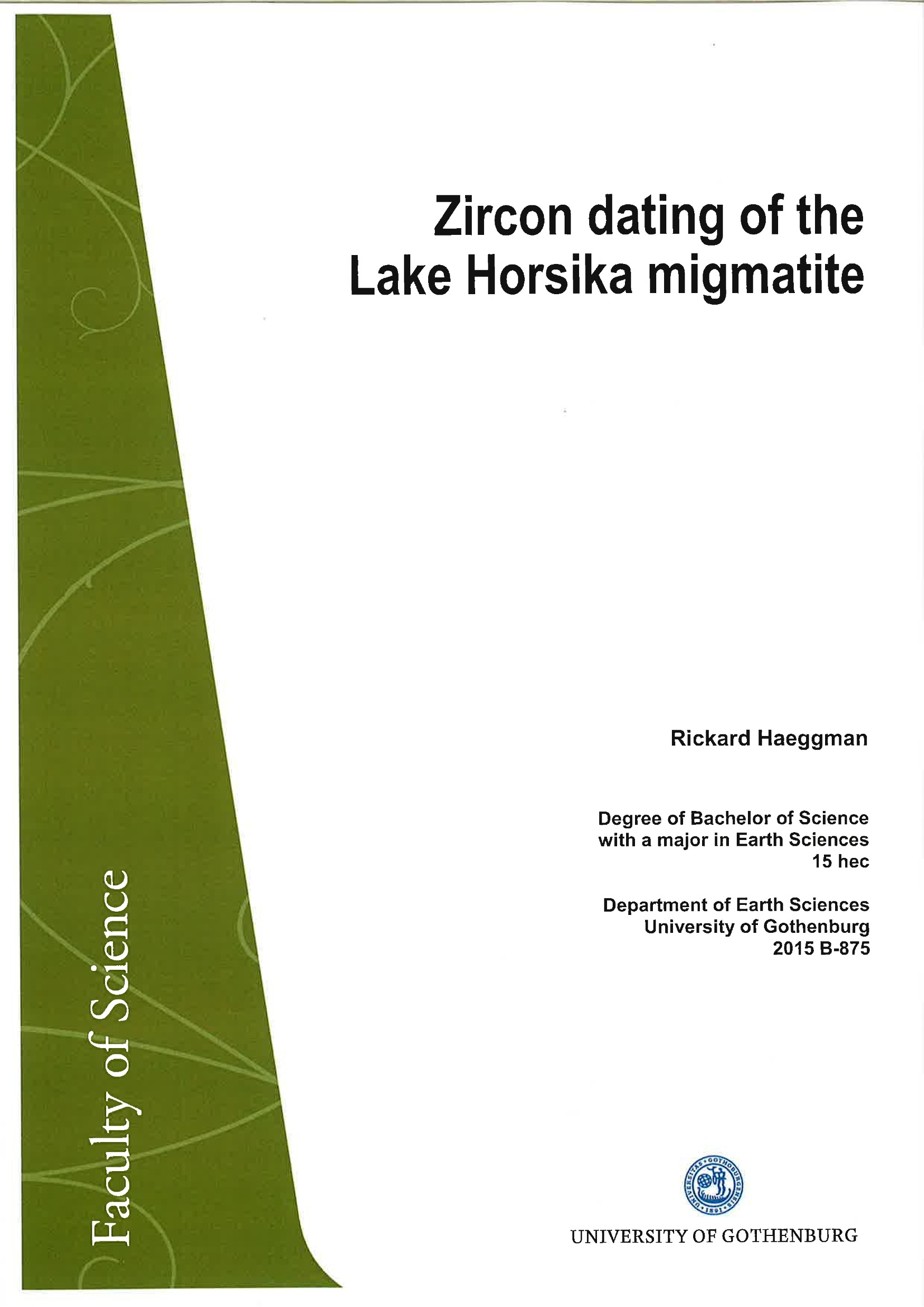
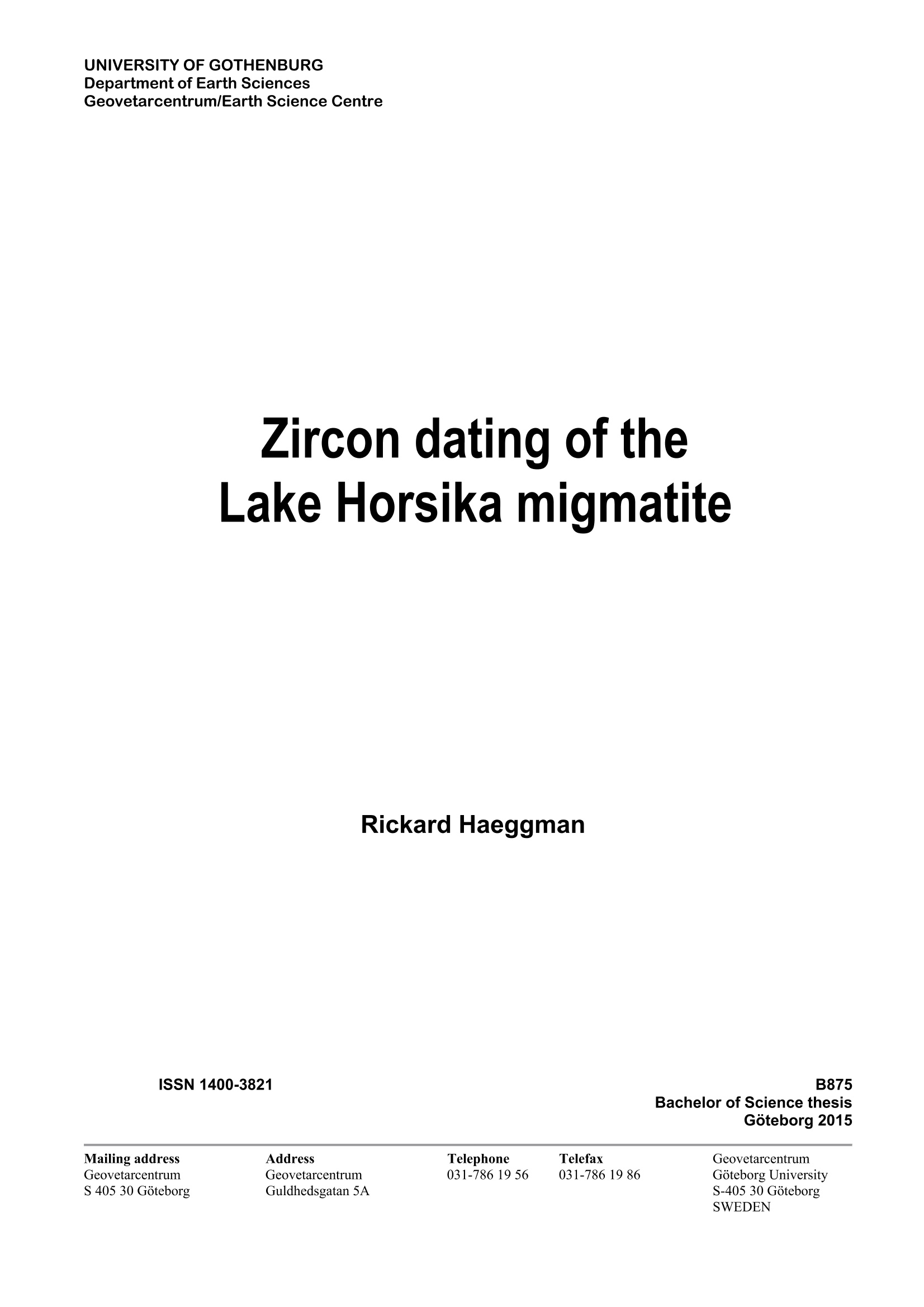
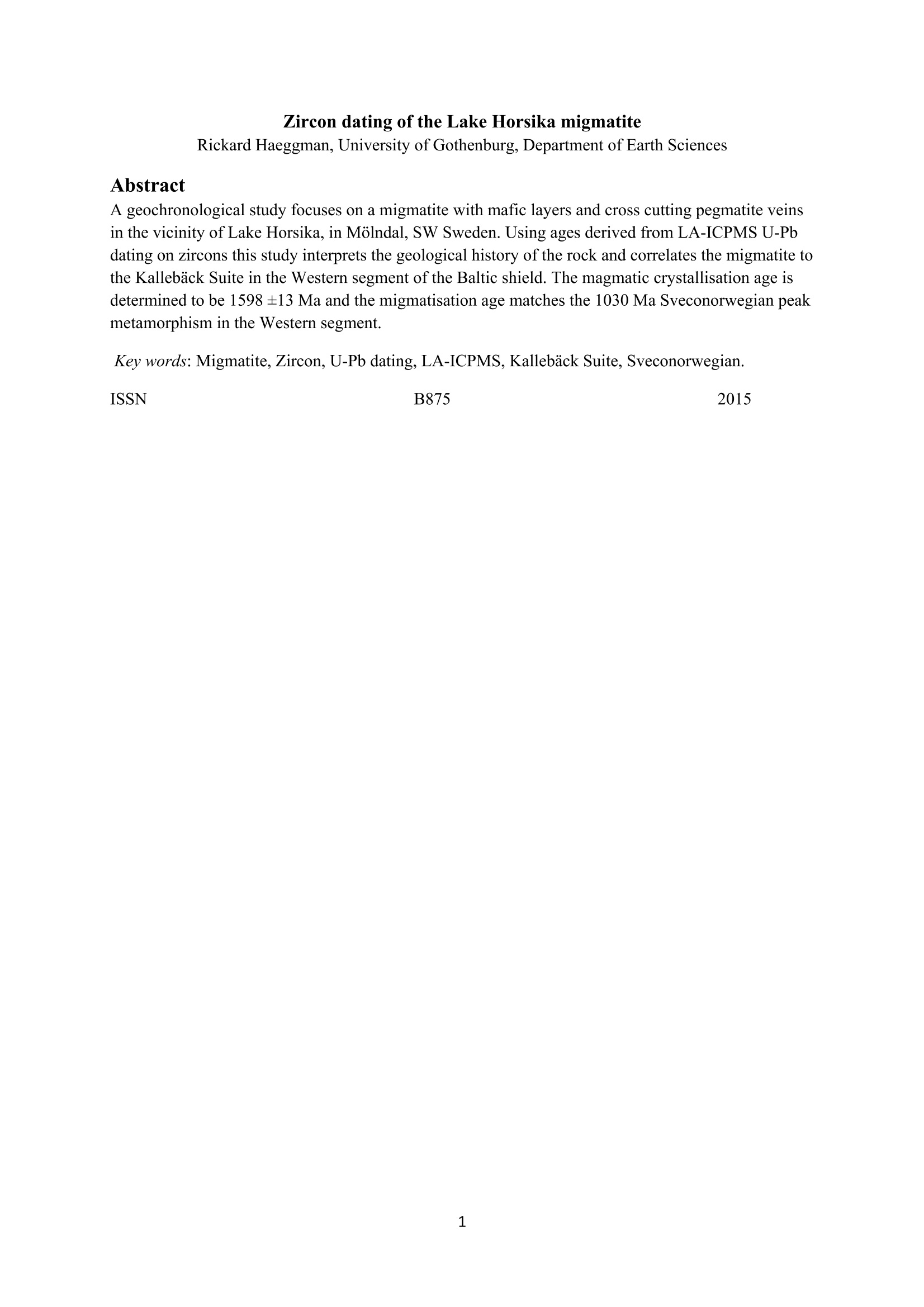

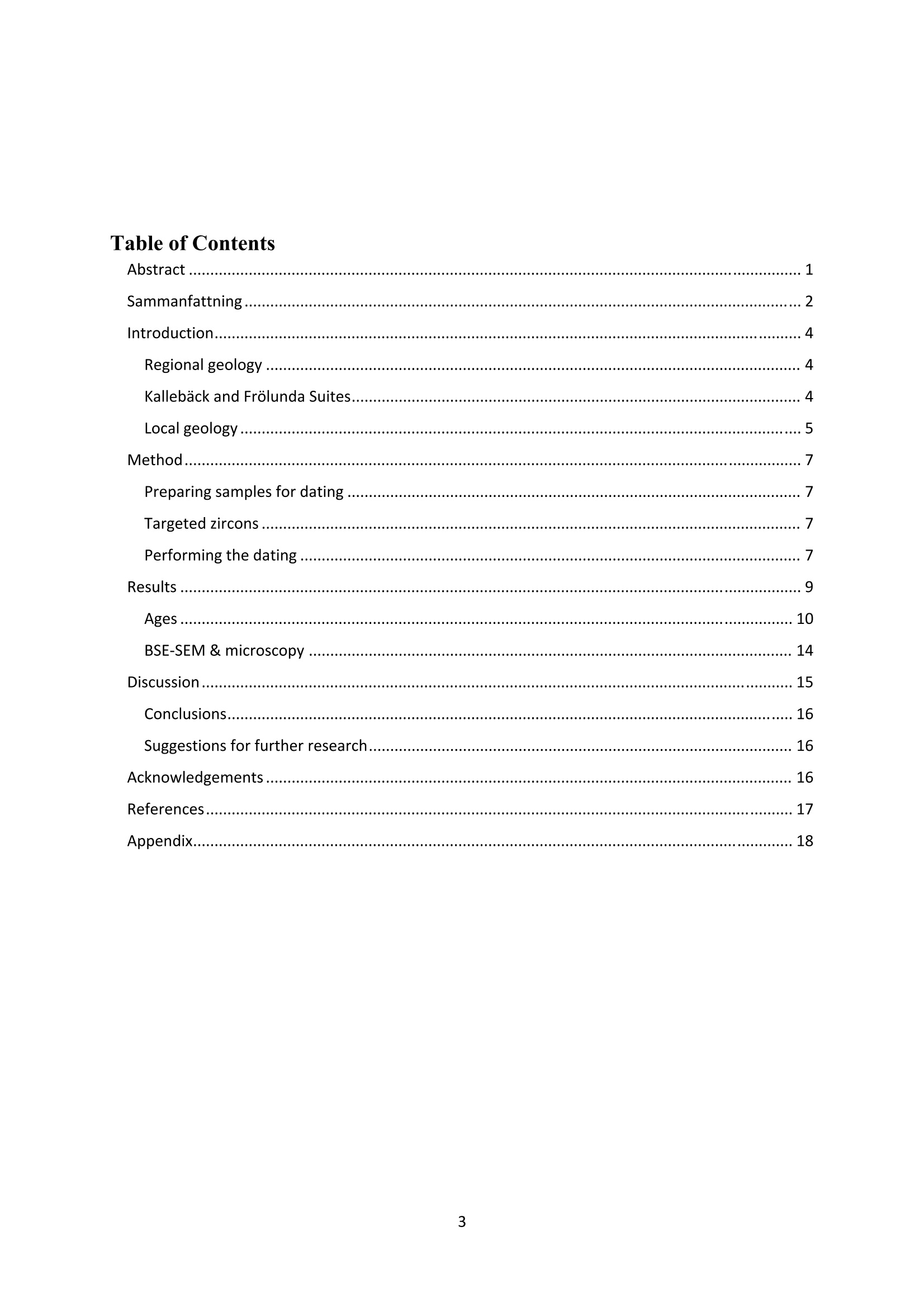

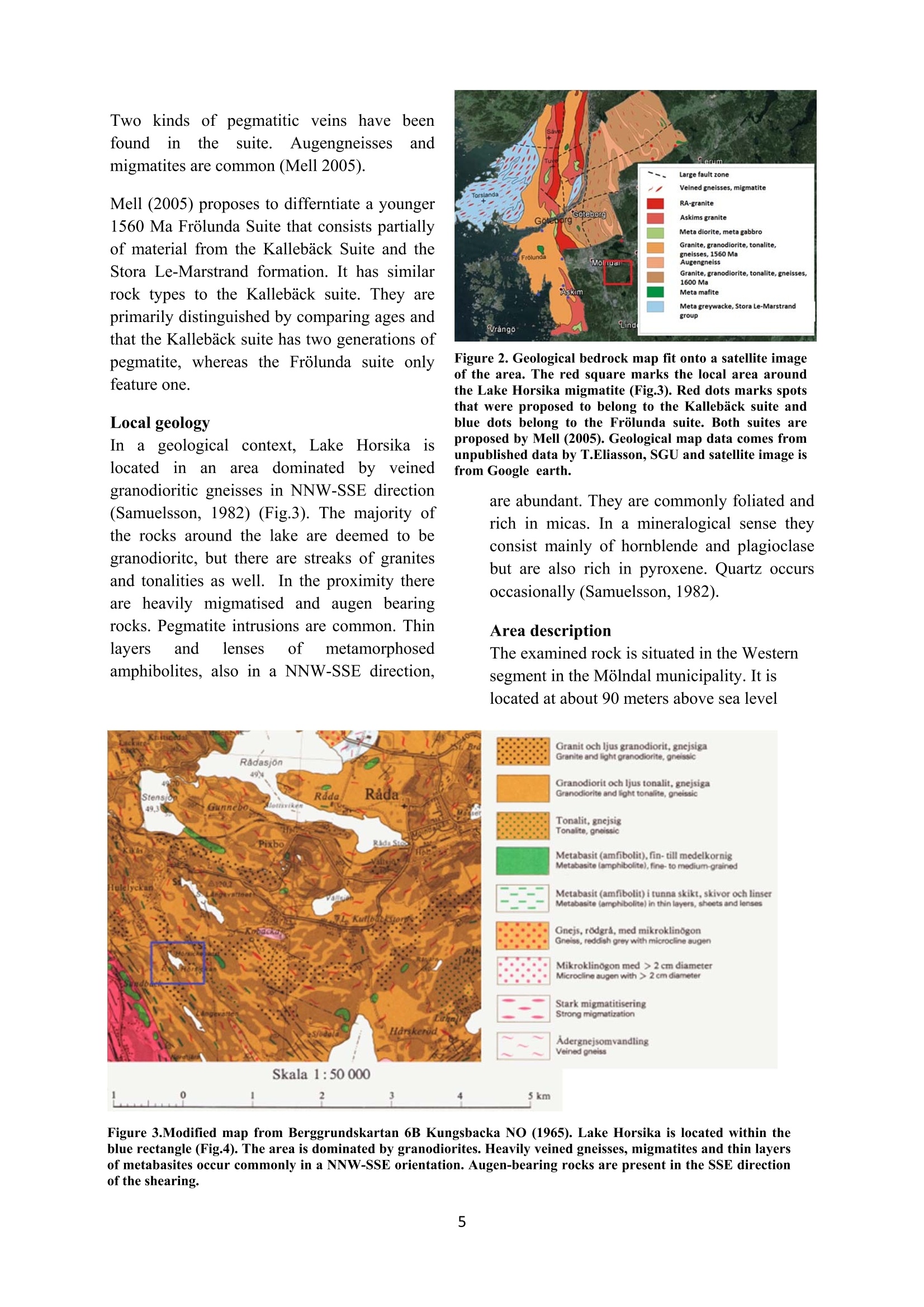
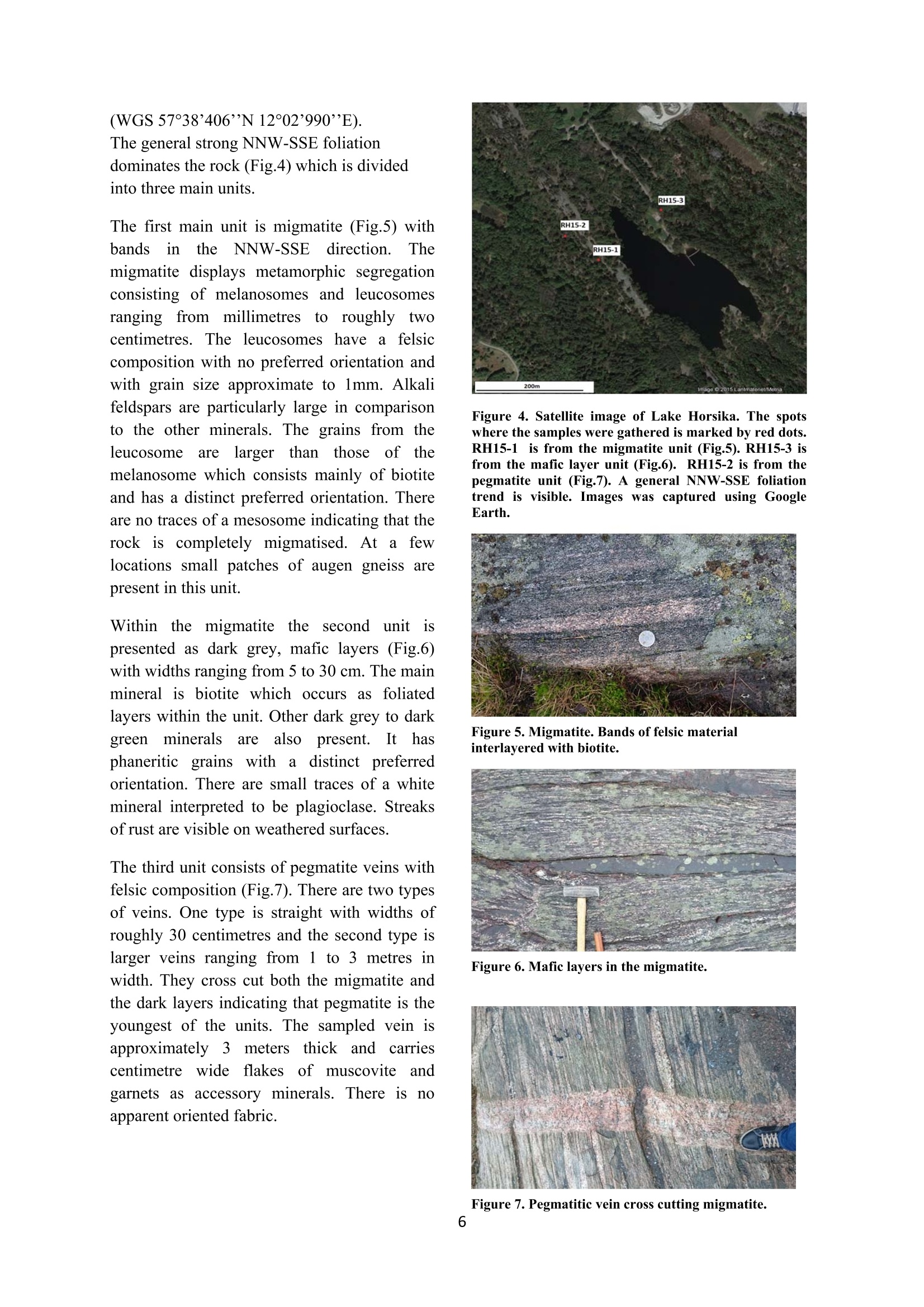
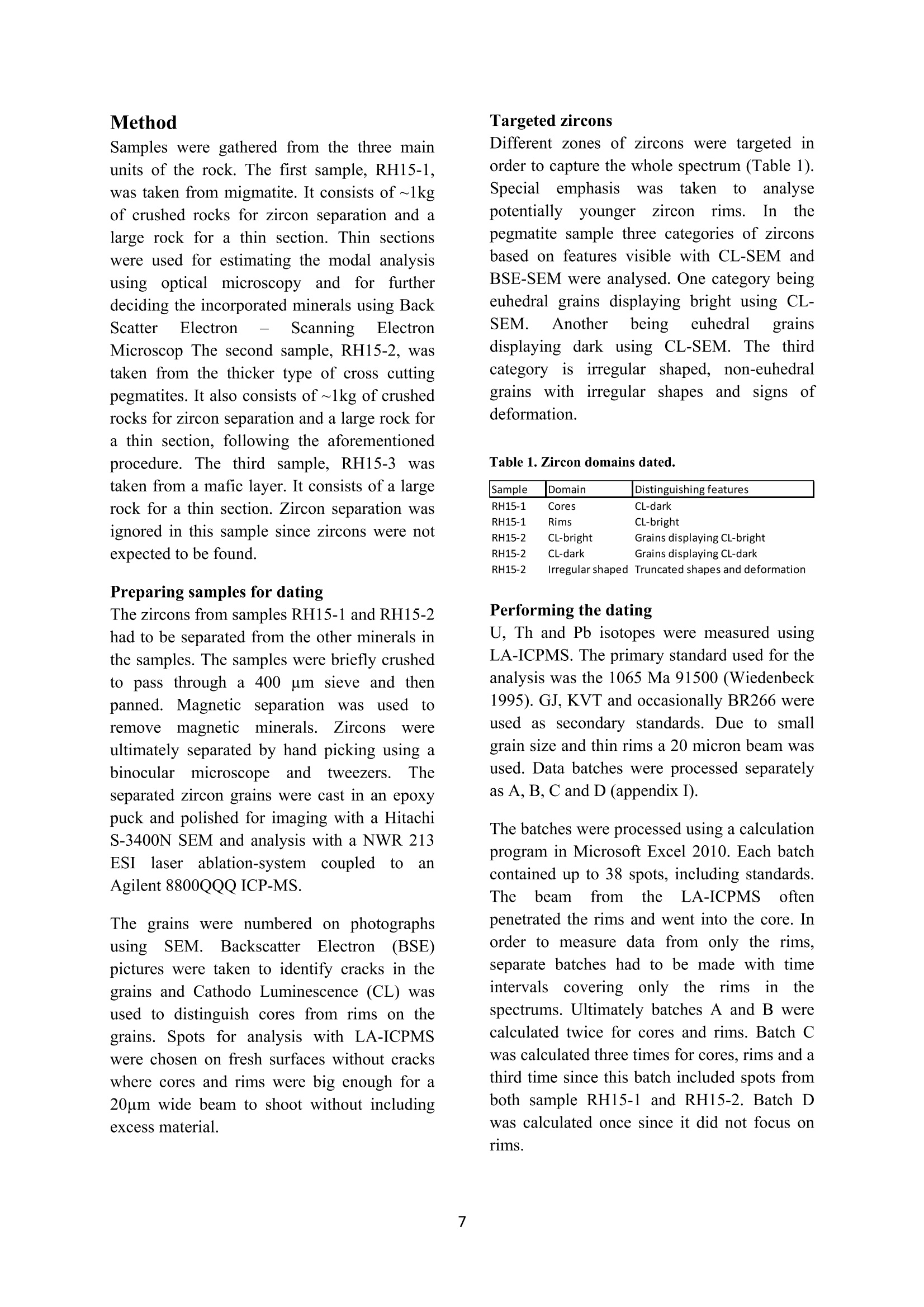
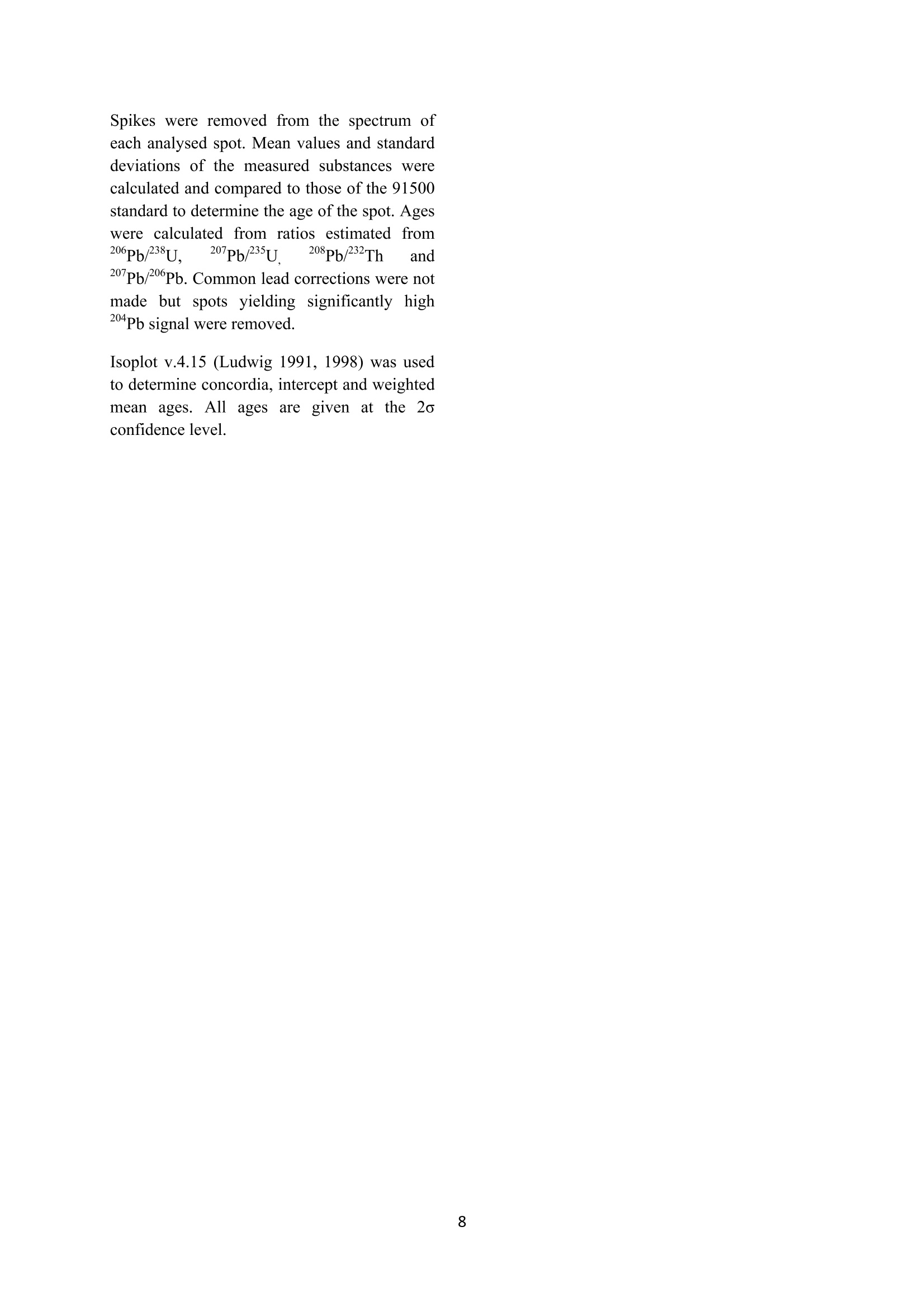
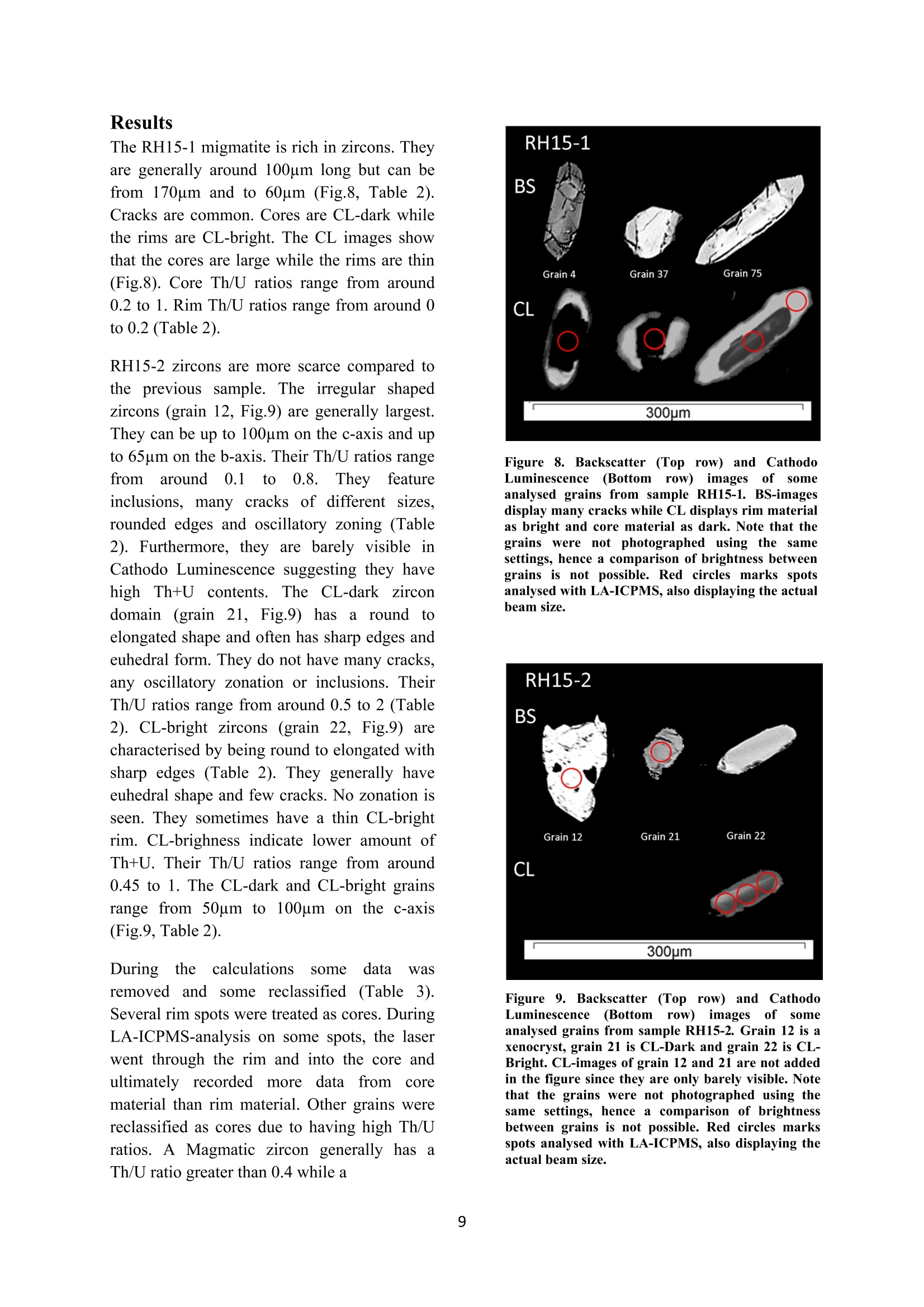
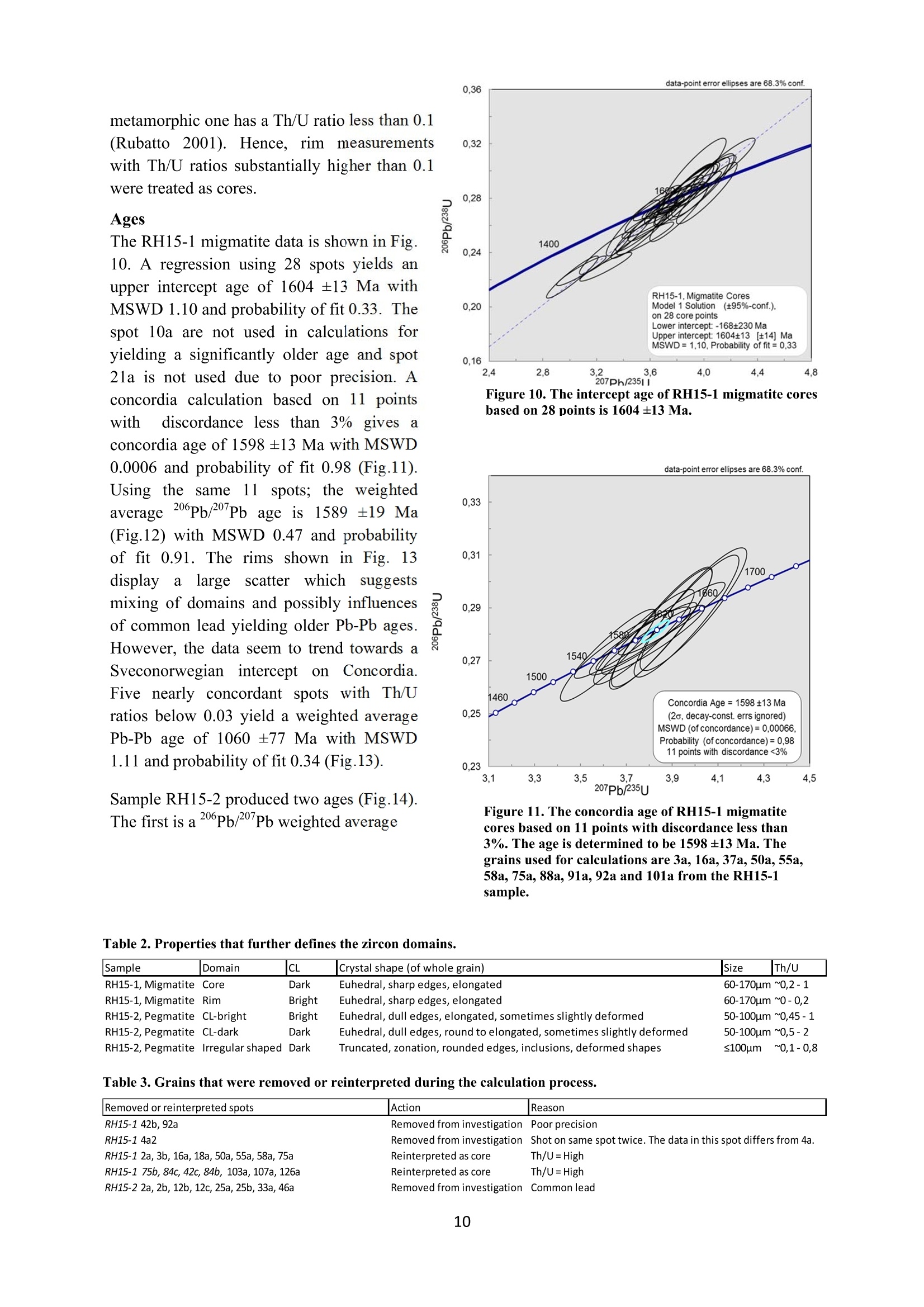
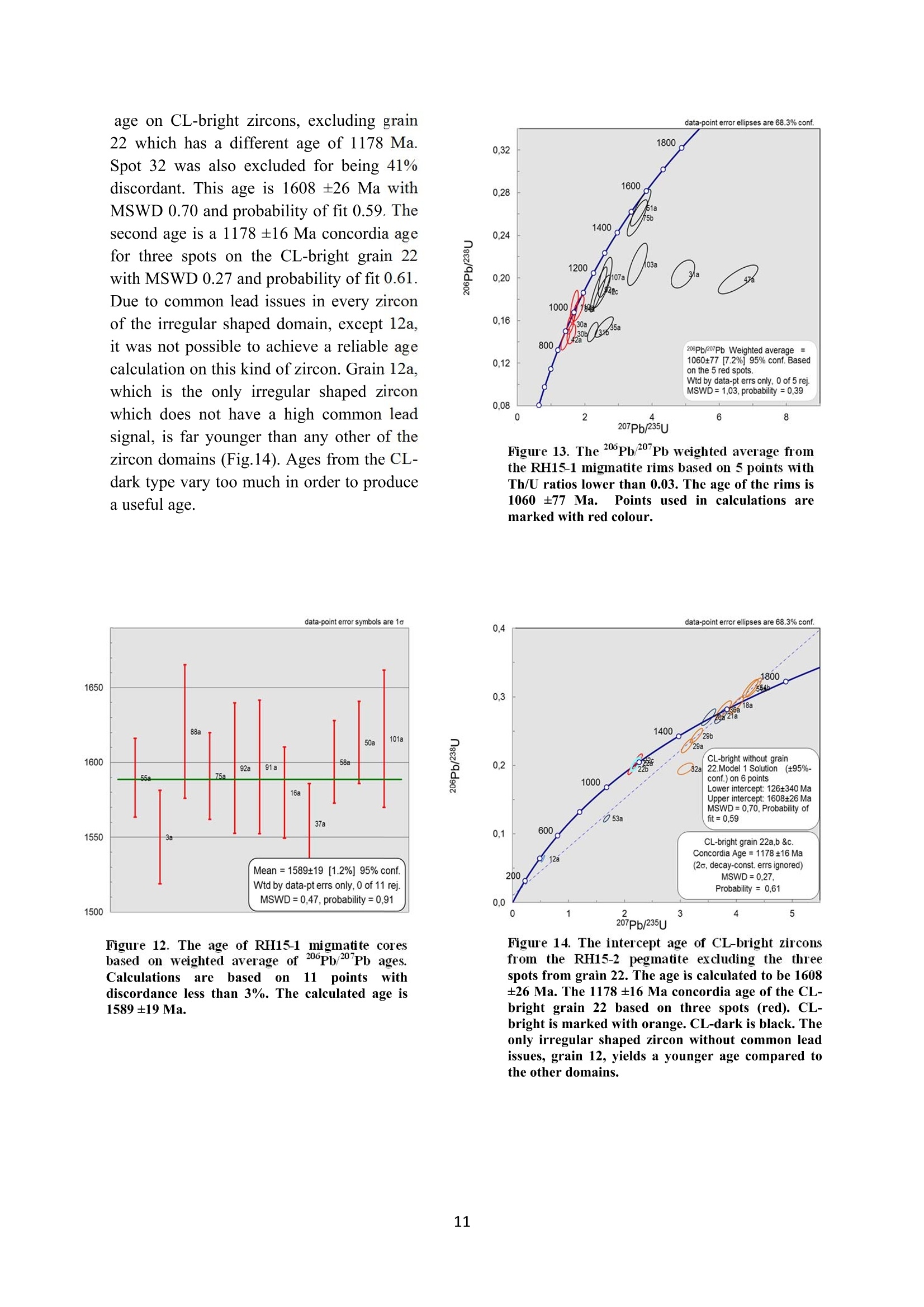

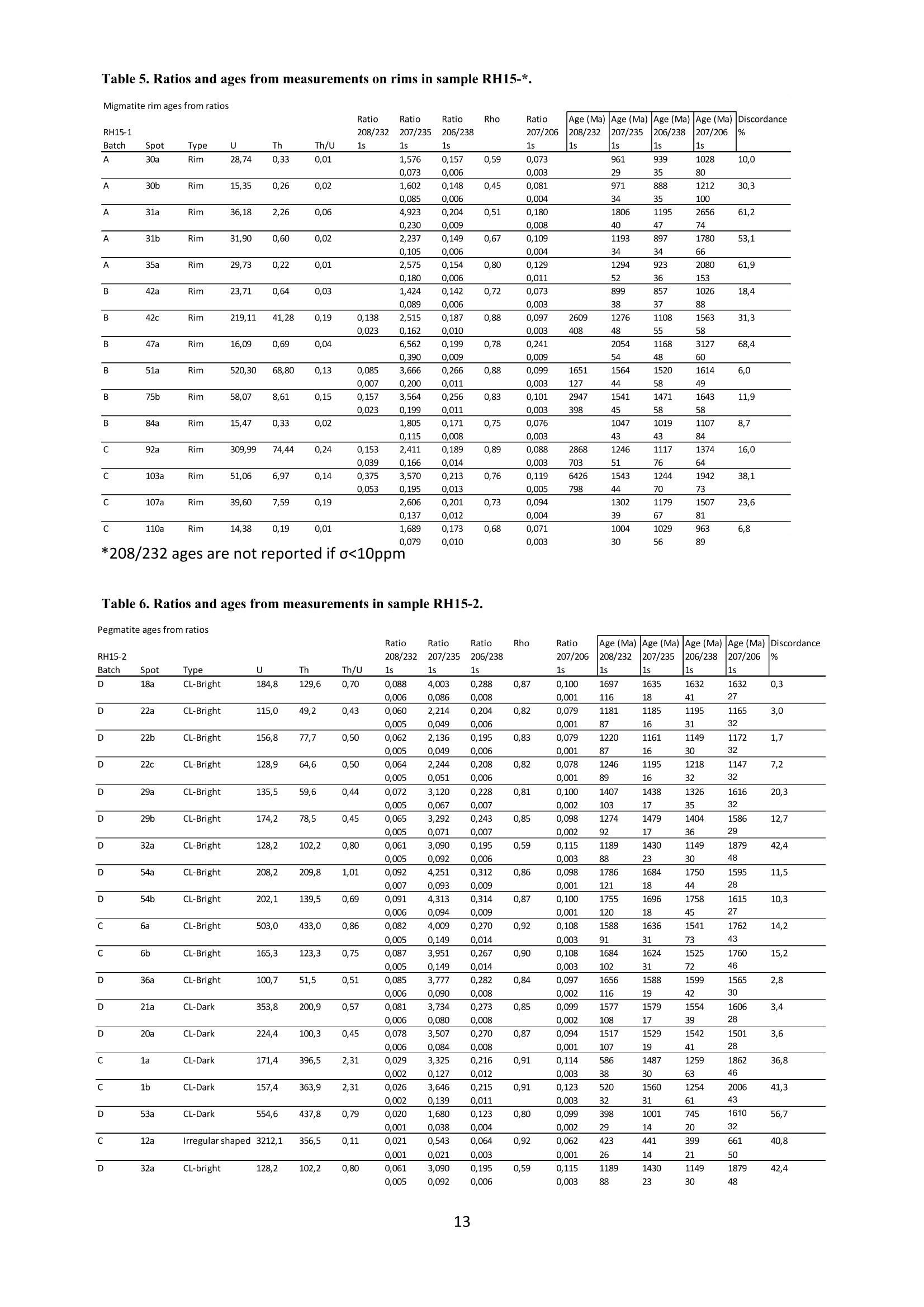
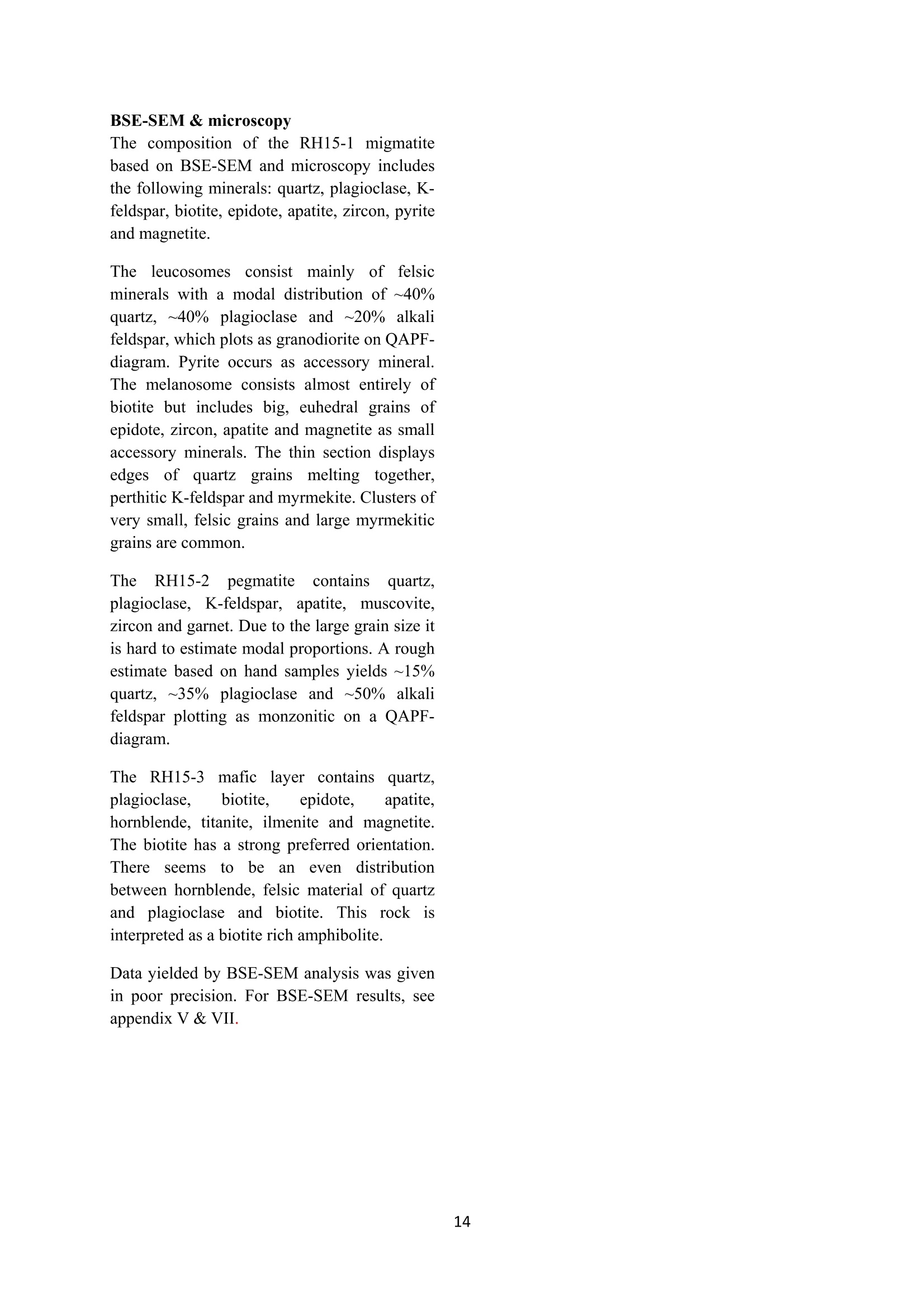

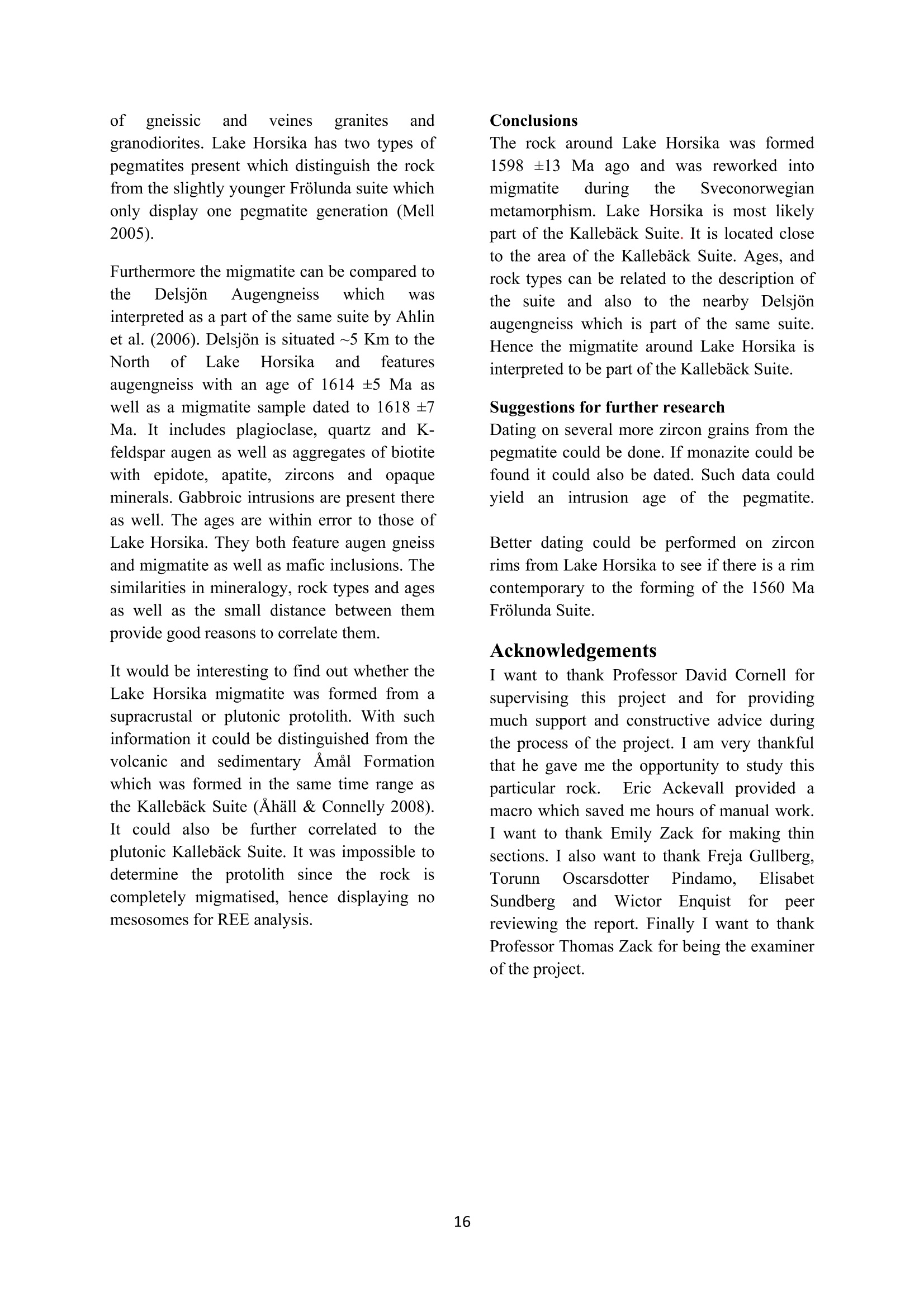
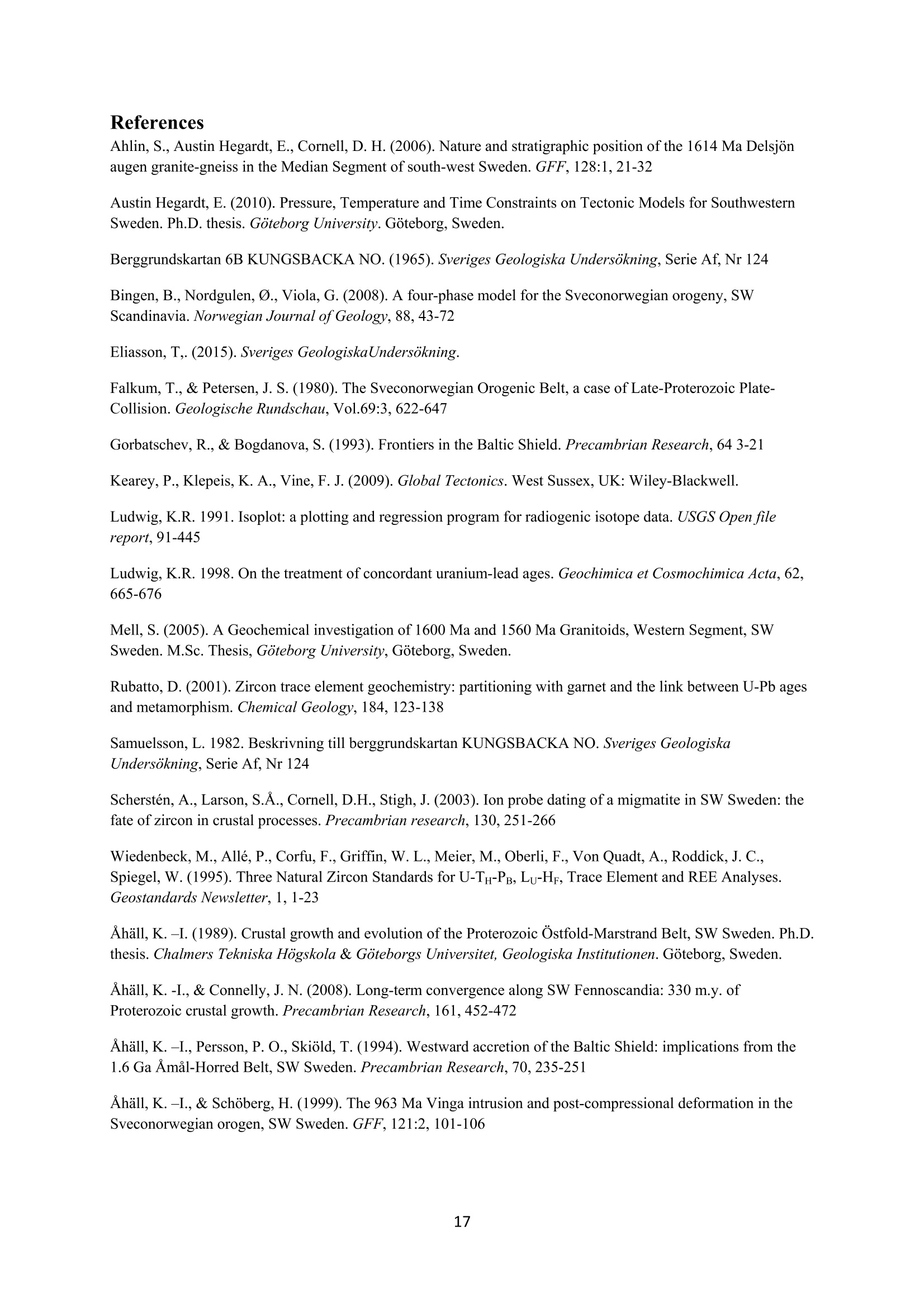

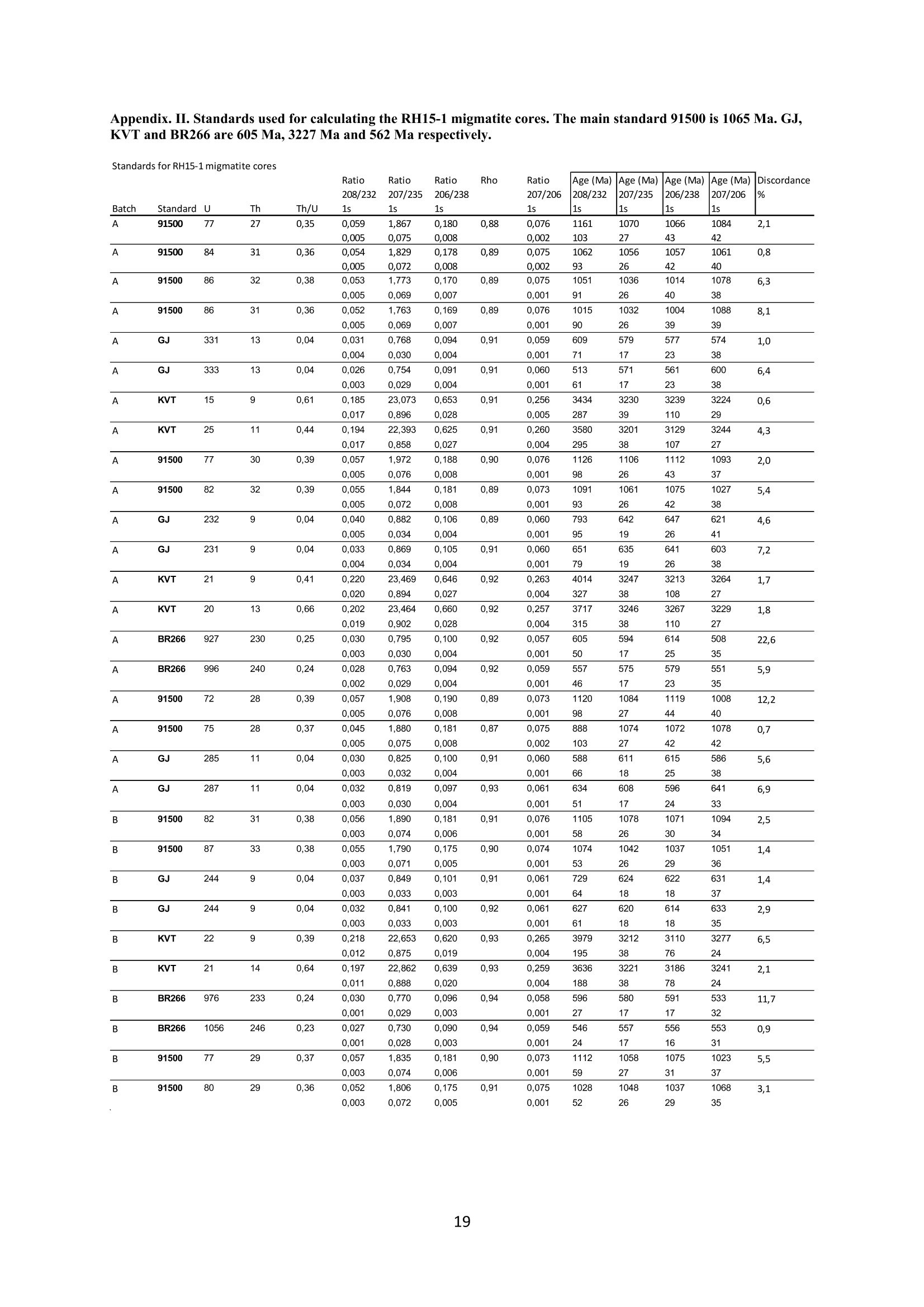
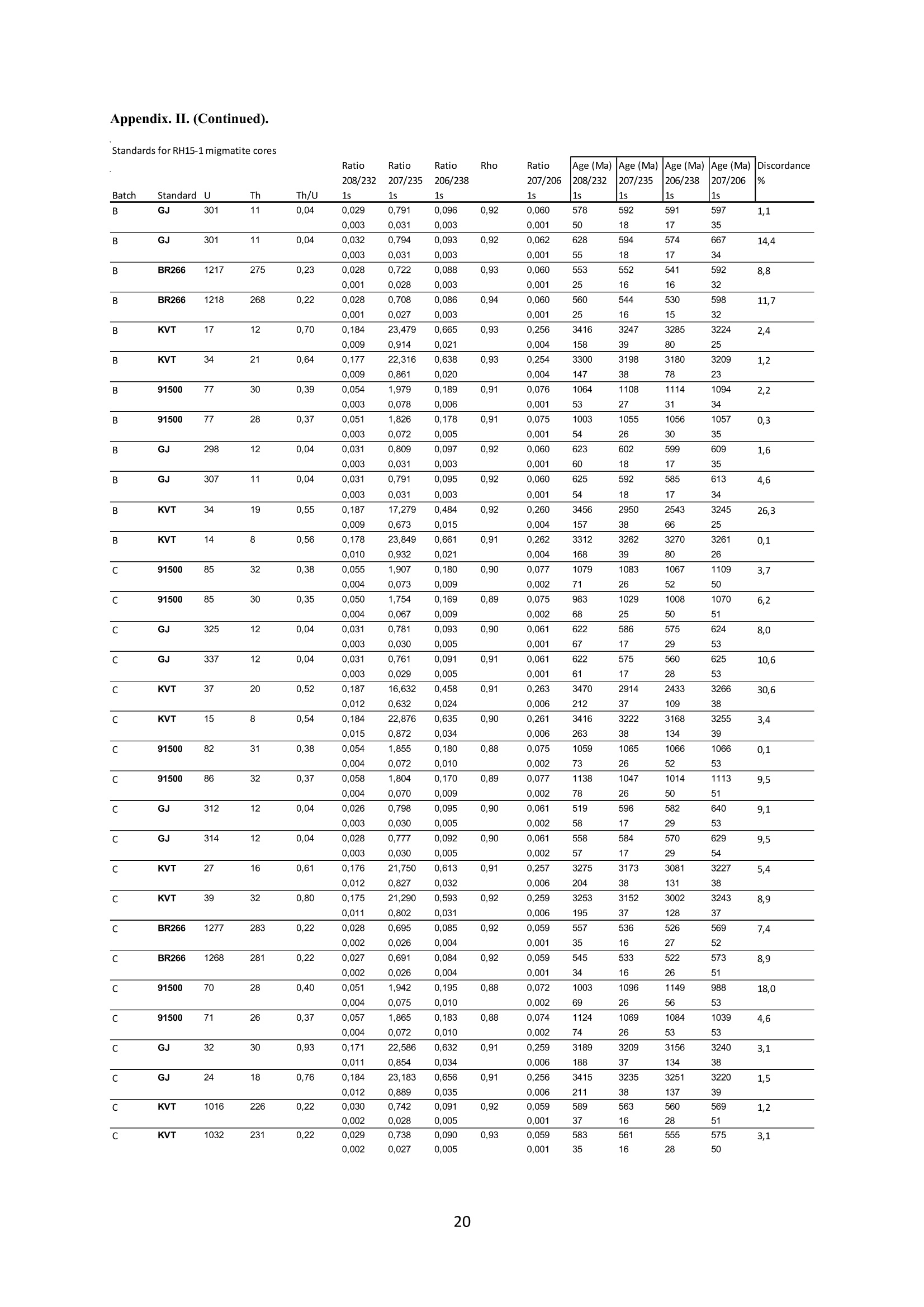

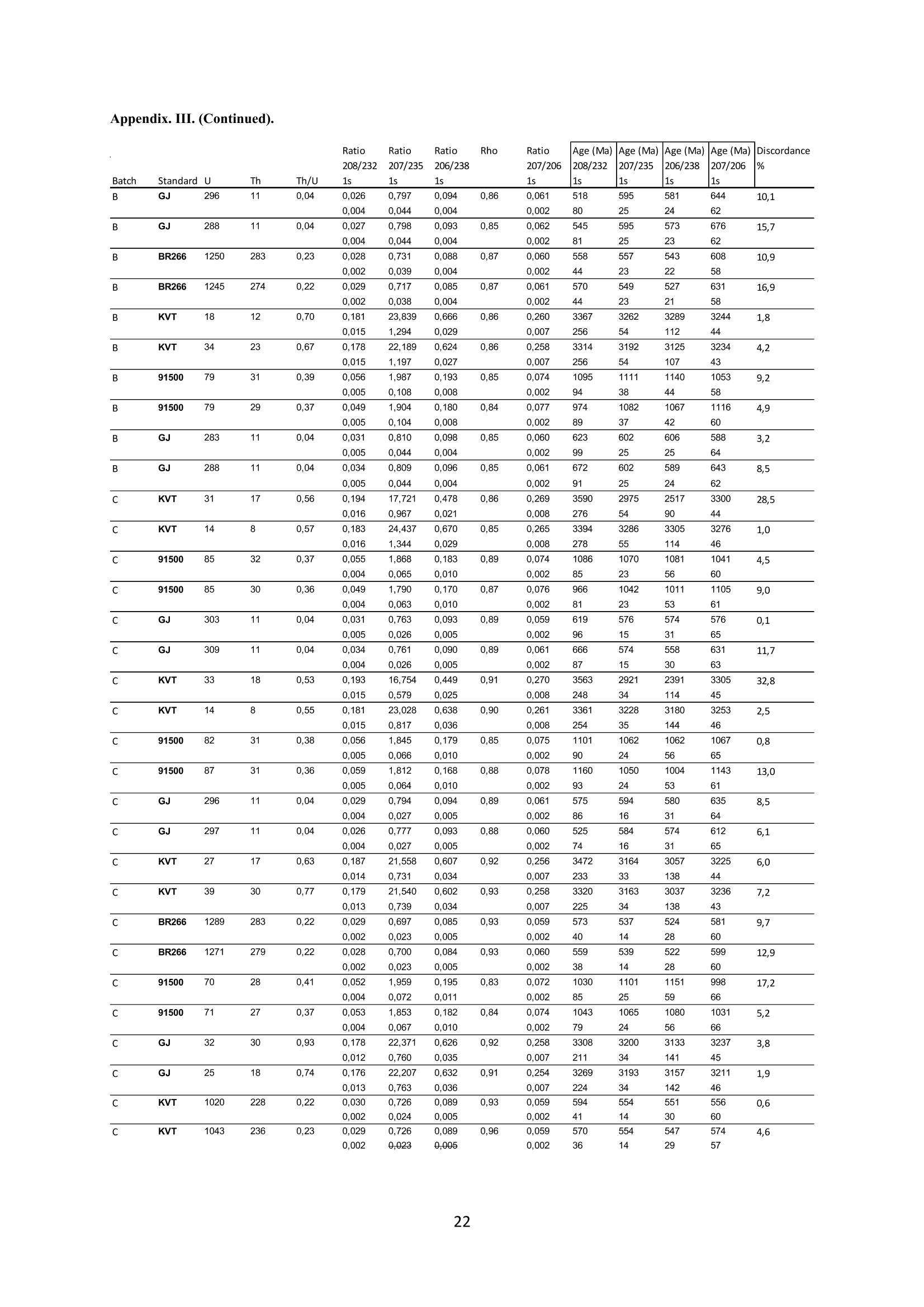
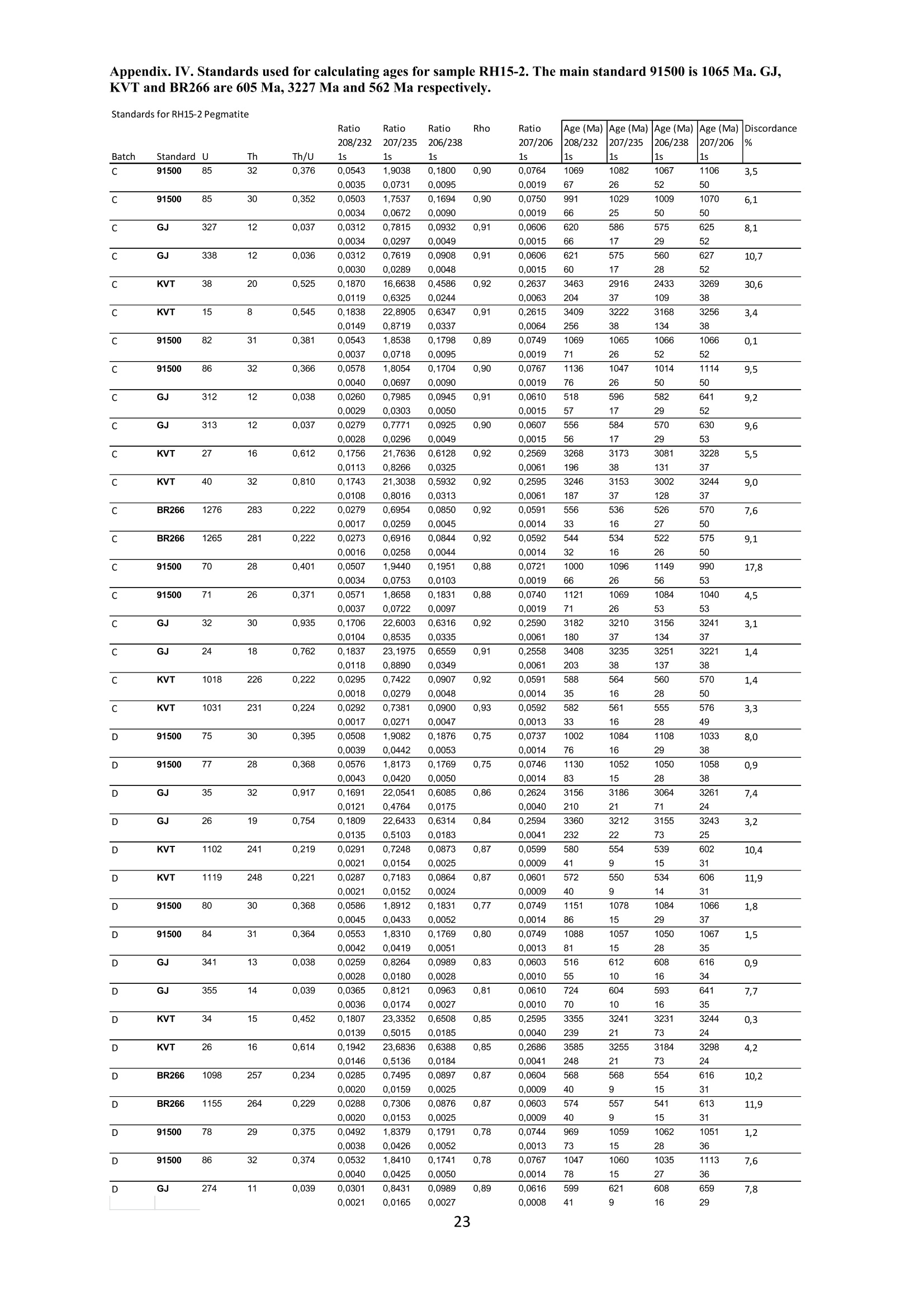


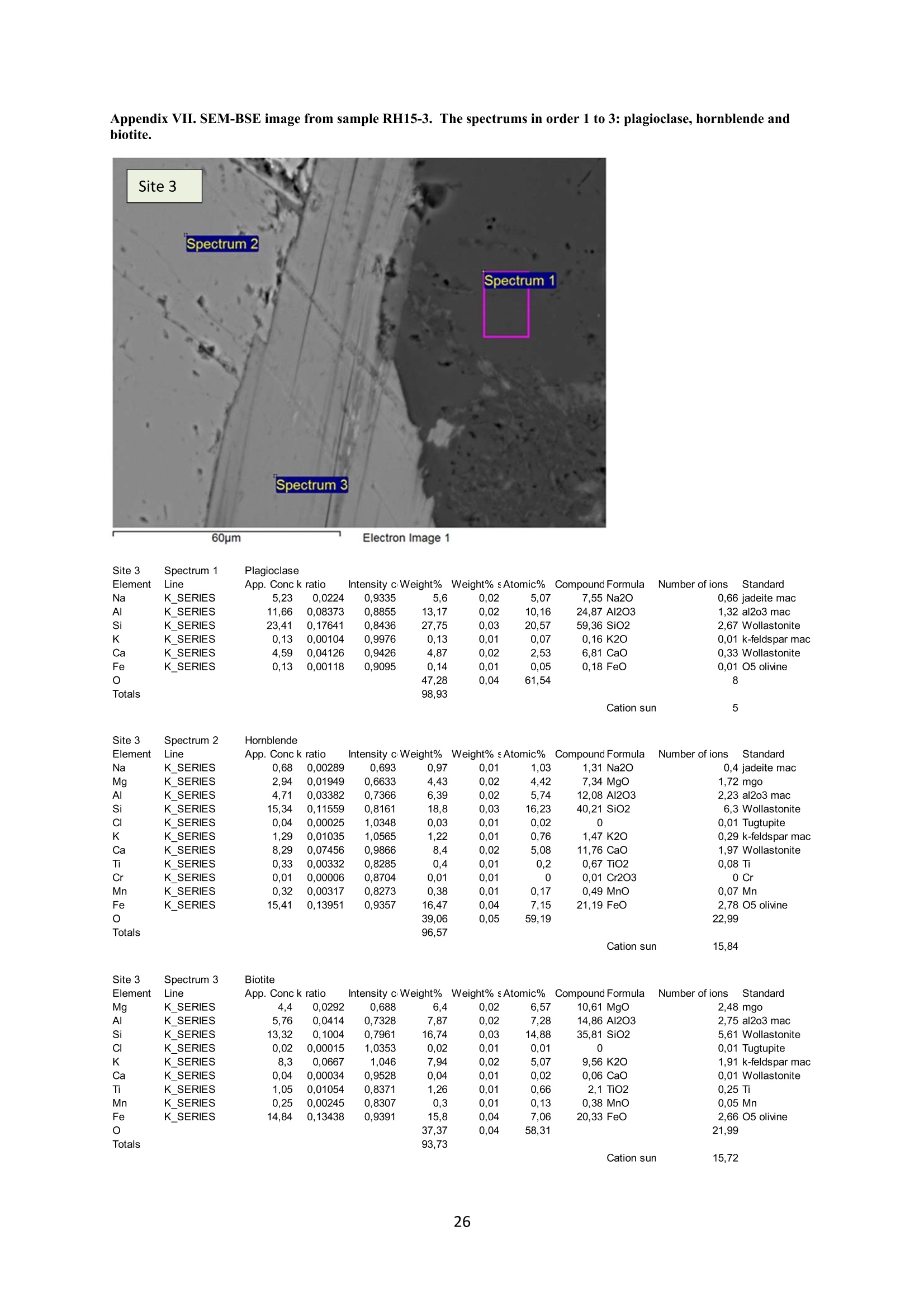
还剩26页未读,是否继续阅读?
上海凯来仪器有限公司为您提供《Horsika湖混合岩中锆石定年检测方案(激光剥蚀进样)》,该方案主要用于其他中锆石定年检测,参考标准--,《Horsika湖混合岩中锆石定年检测方案(激光剥蚀进样)》用到的仪器有ESL213 灵活的激光剥蚀系统
推荐专场
相关方案
更多
该厂商其他方案
更多

